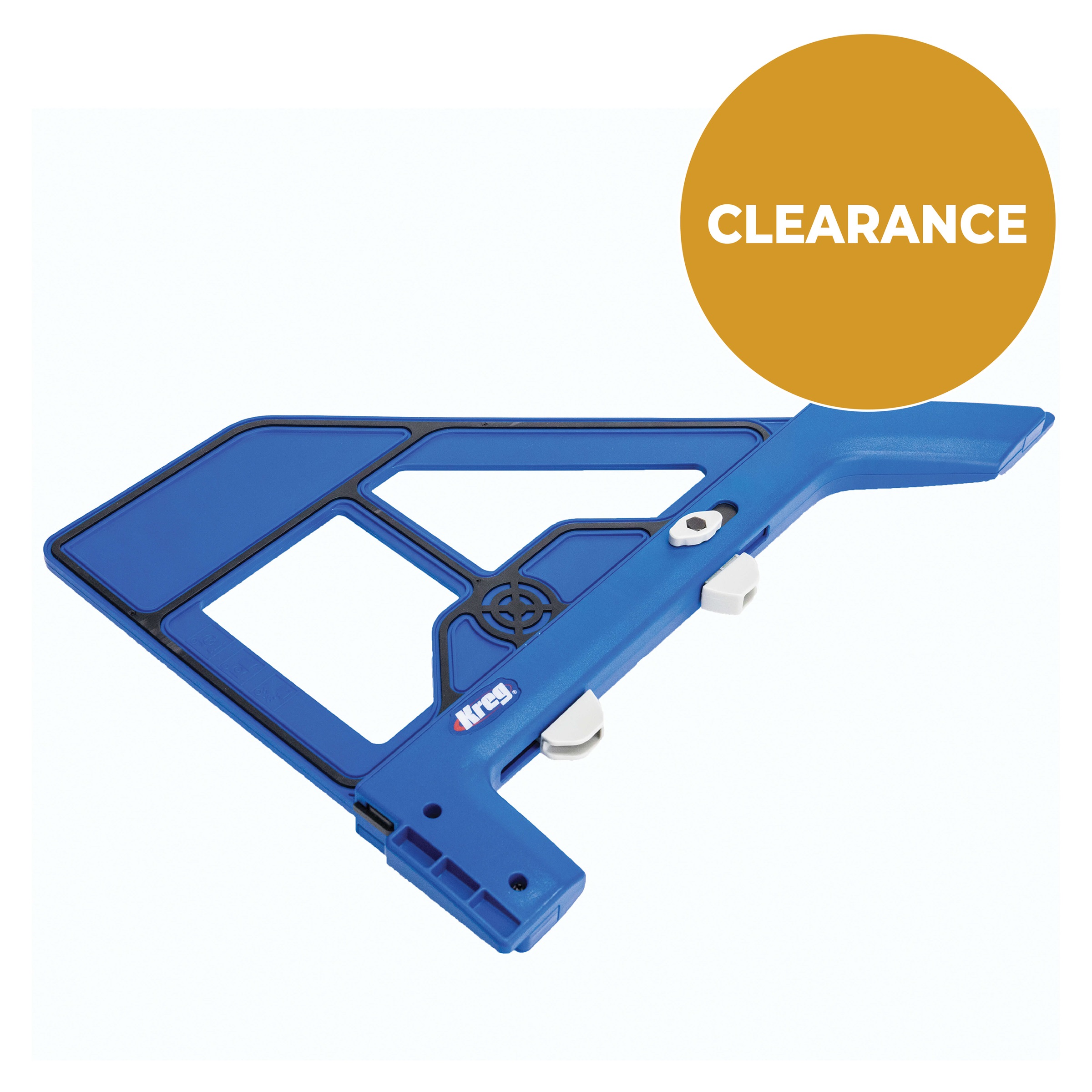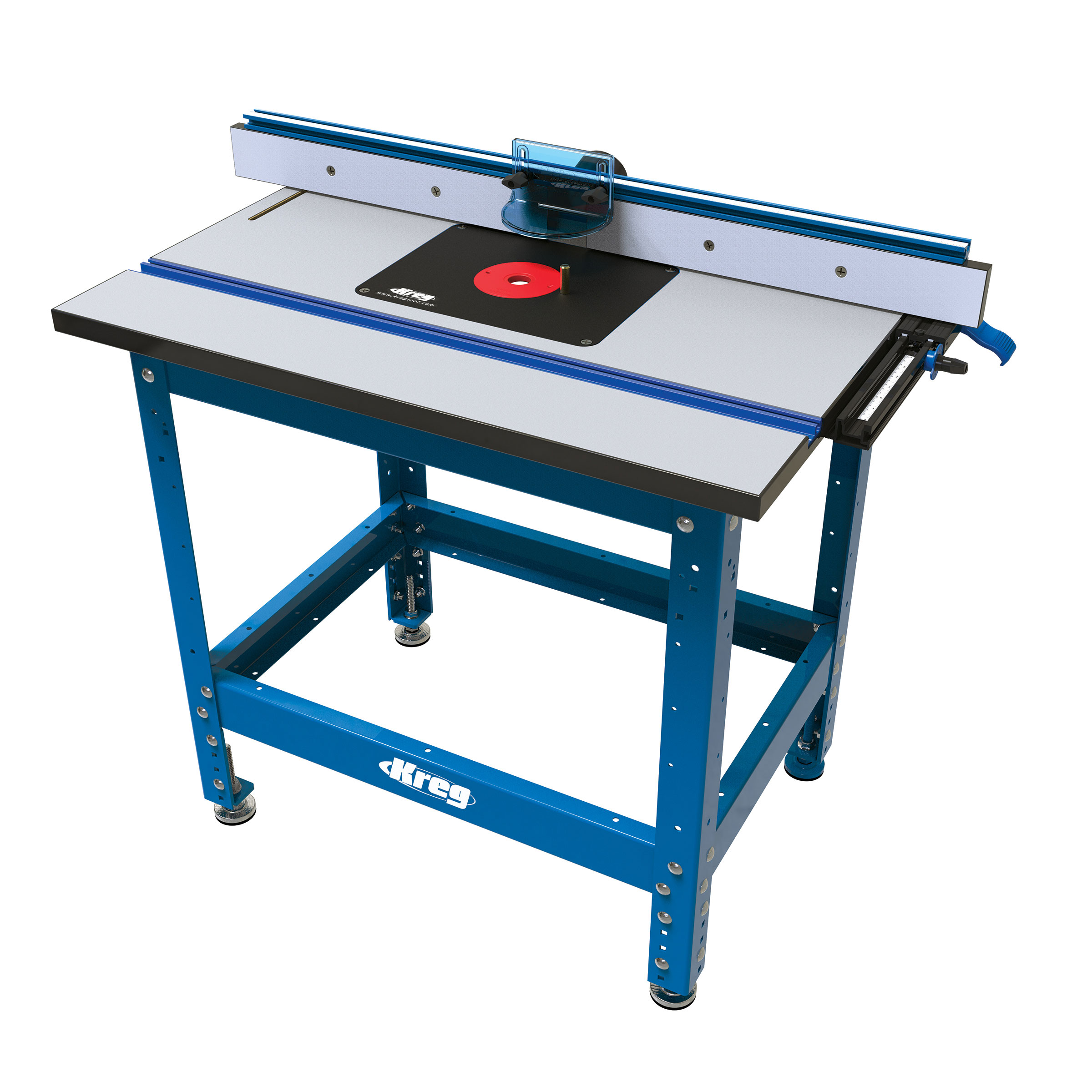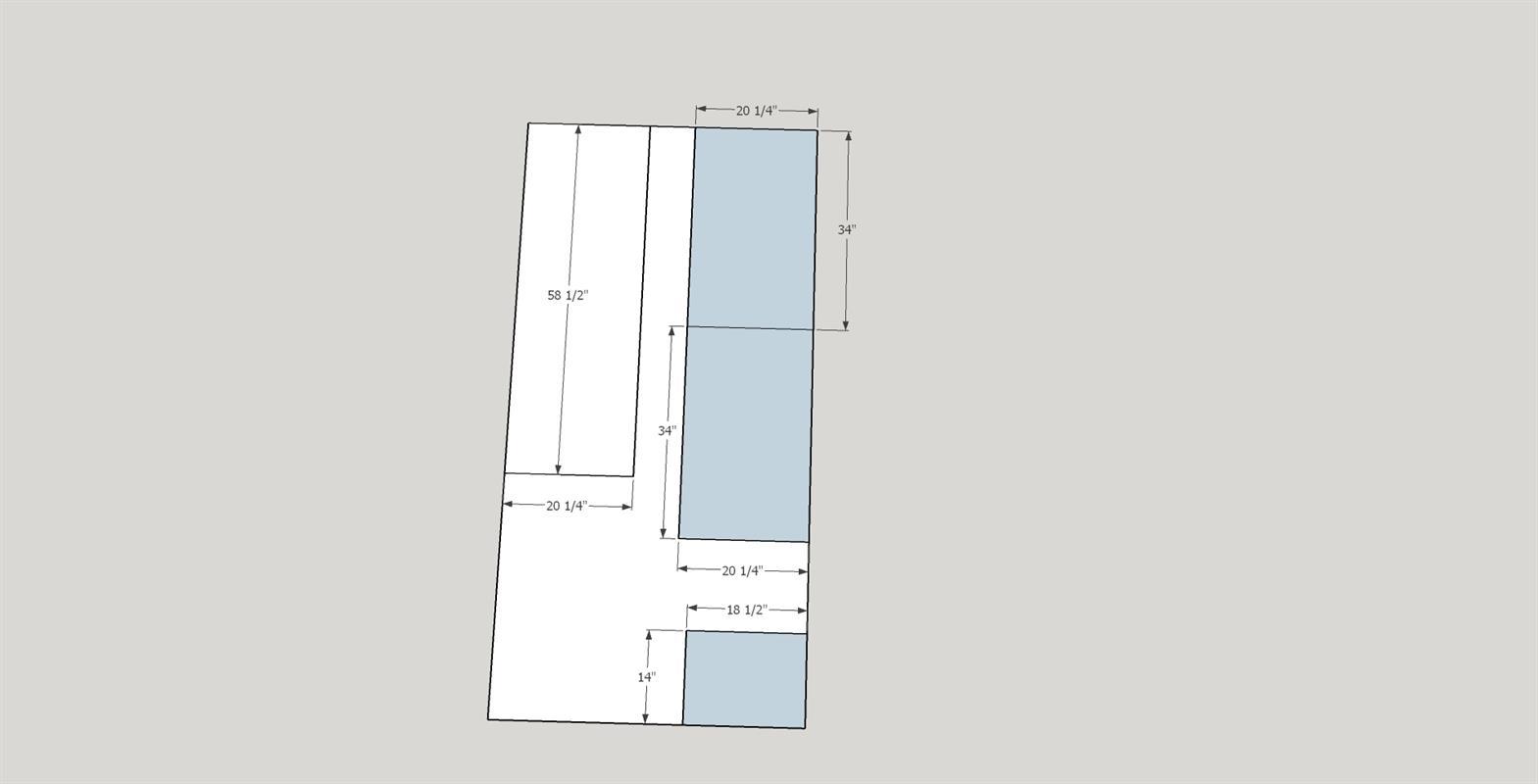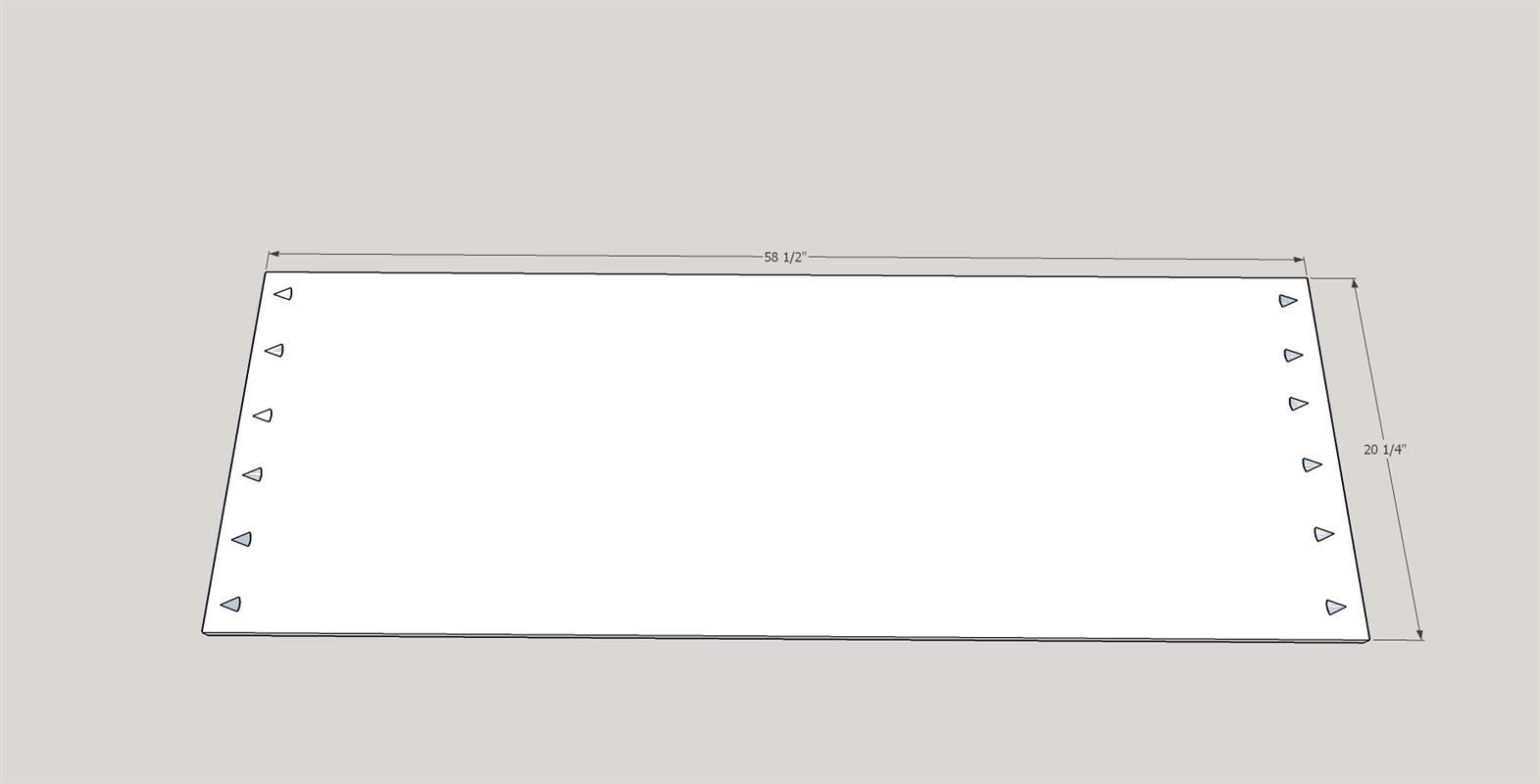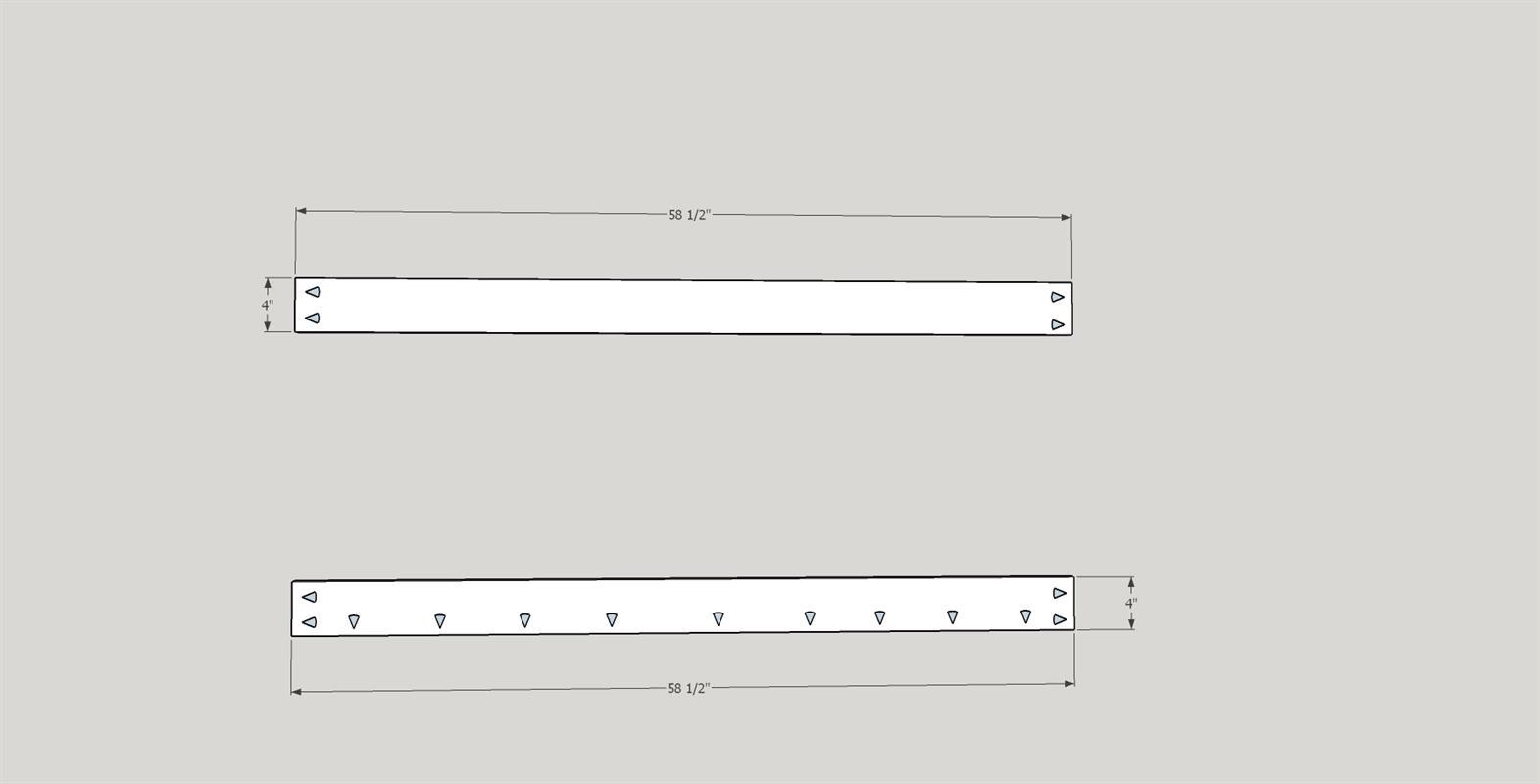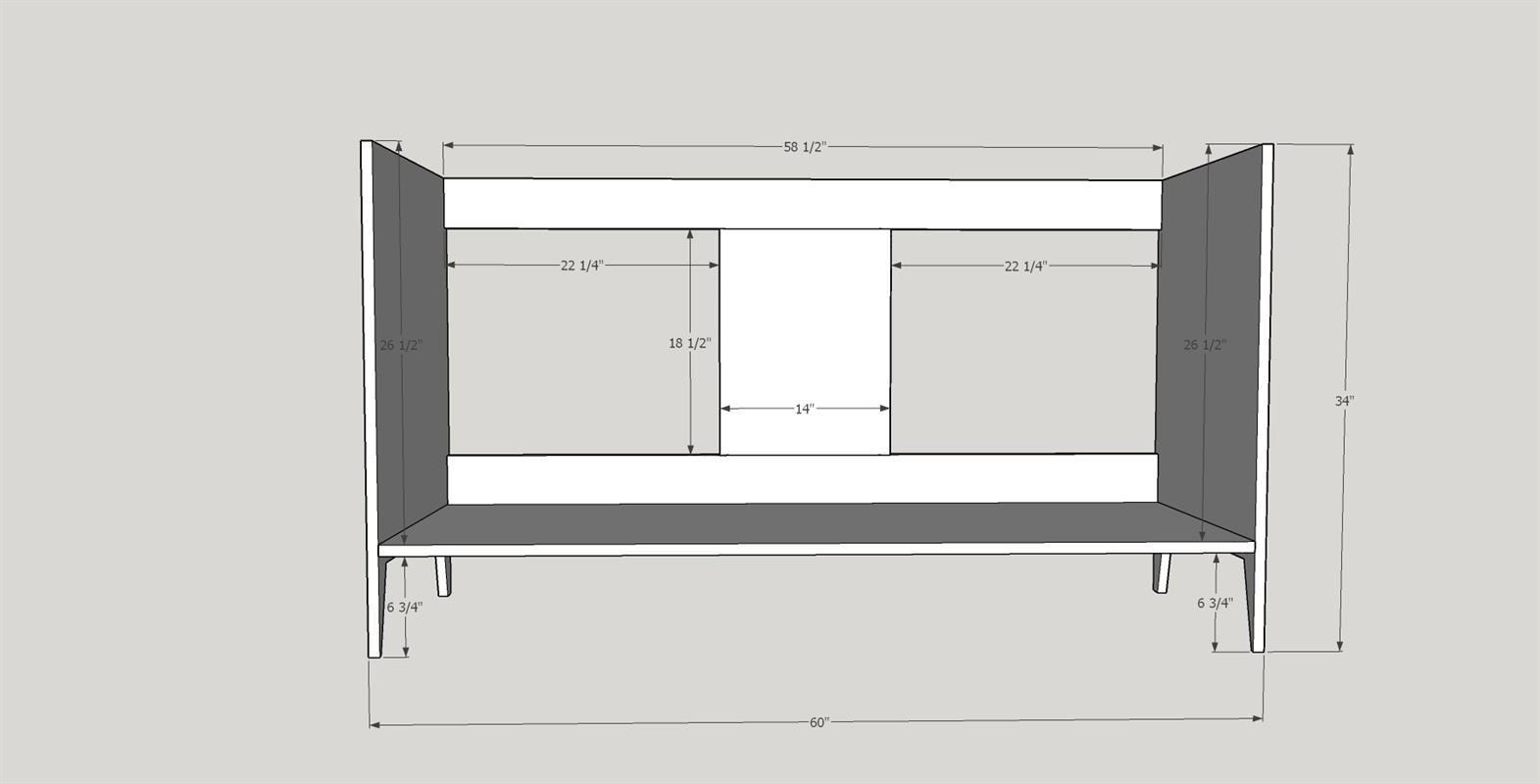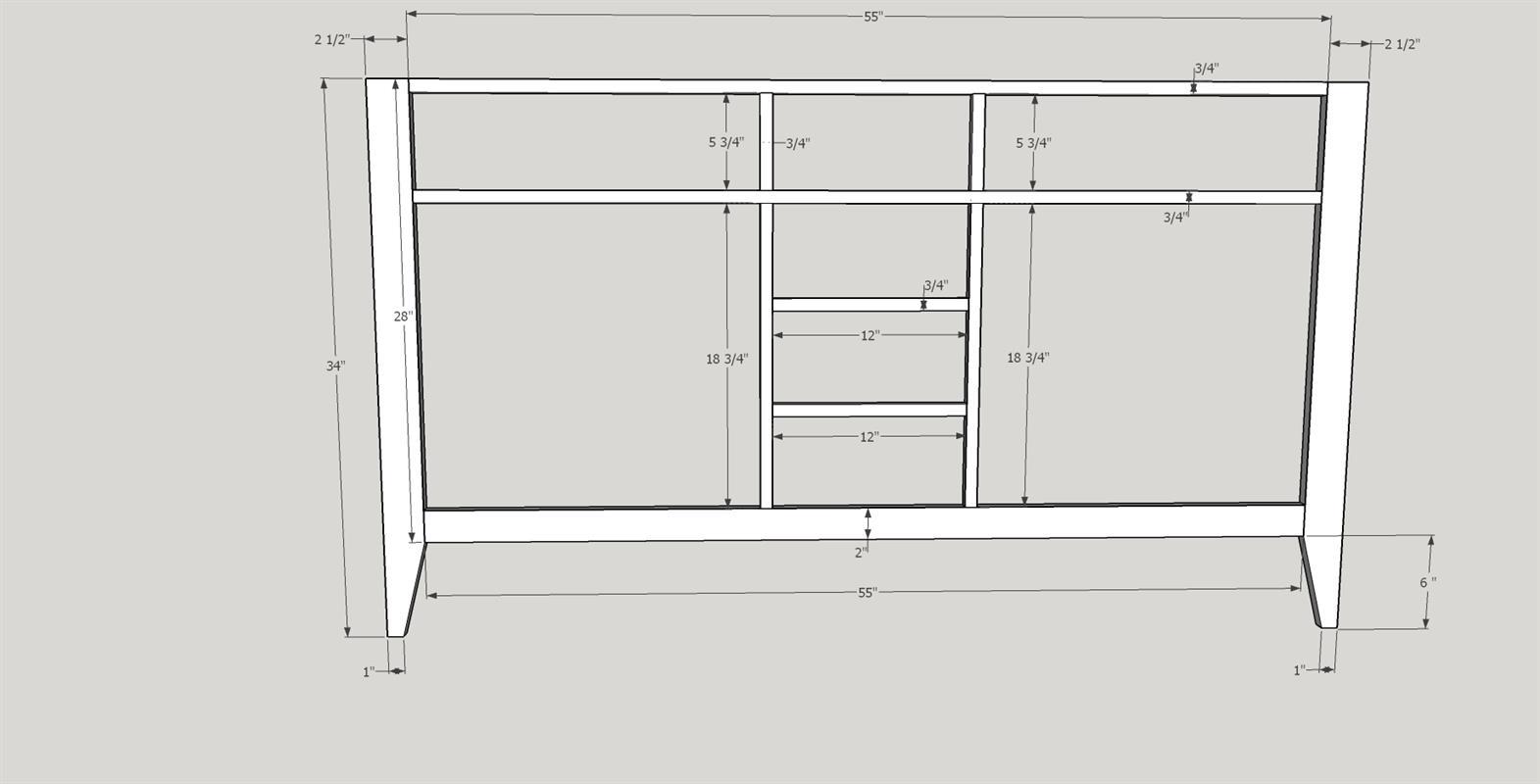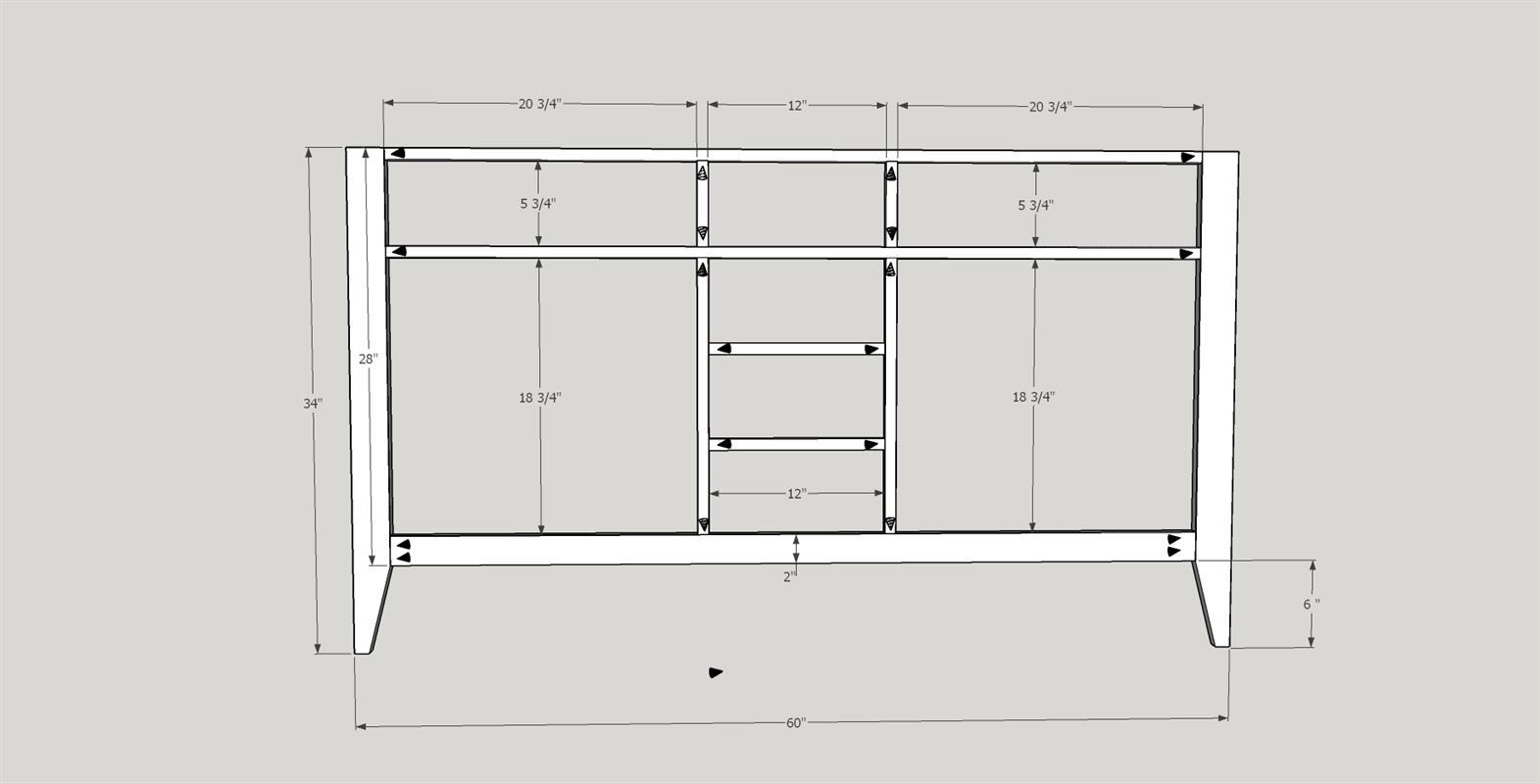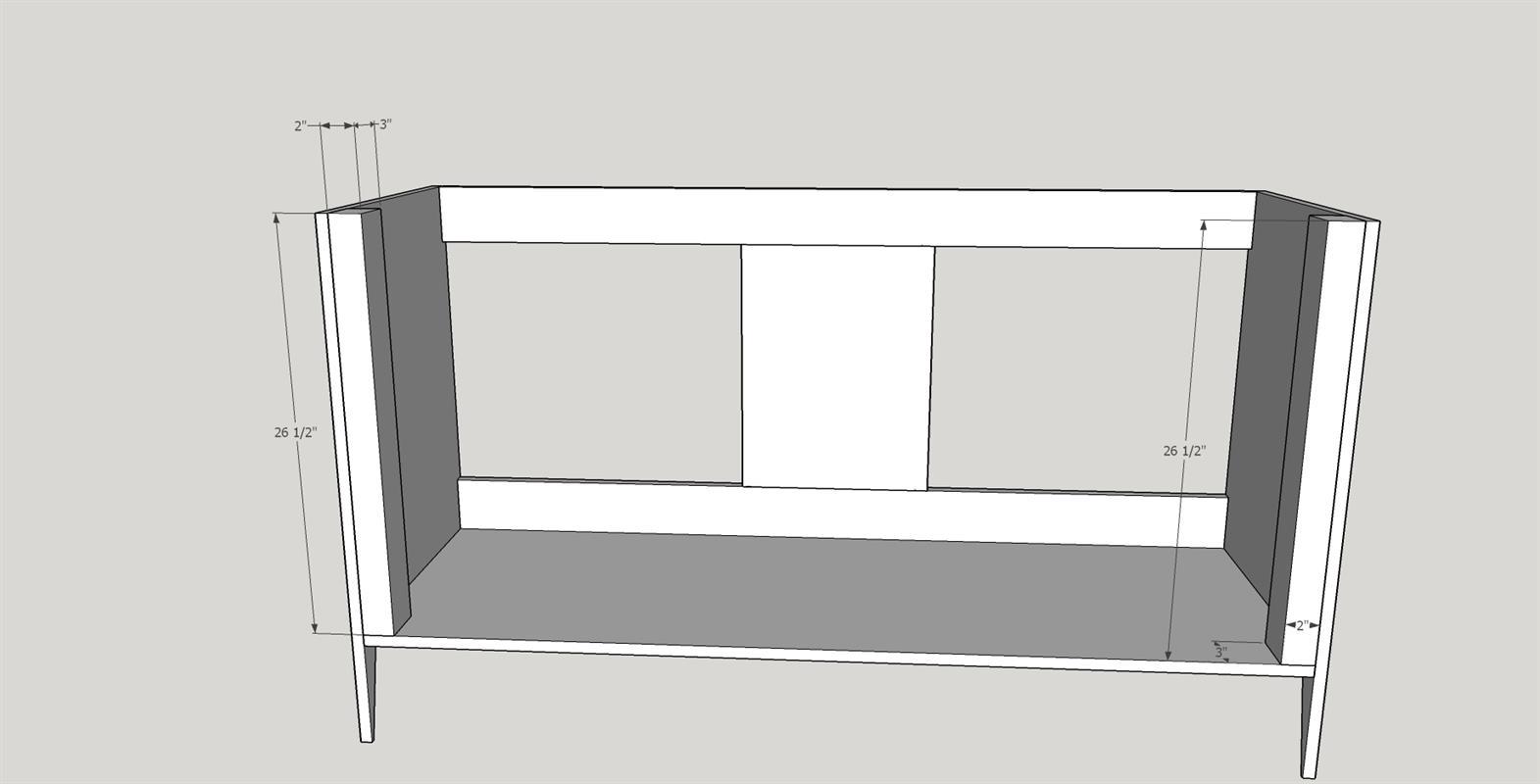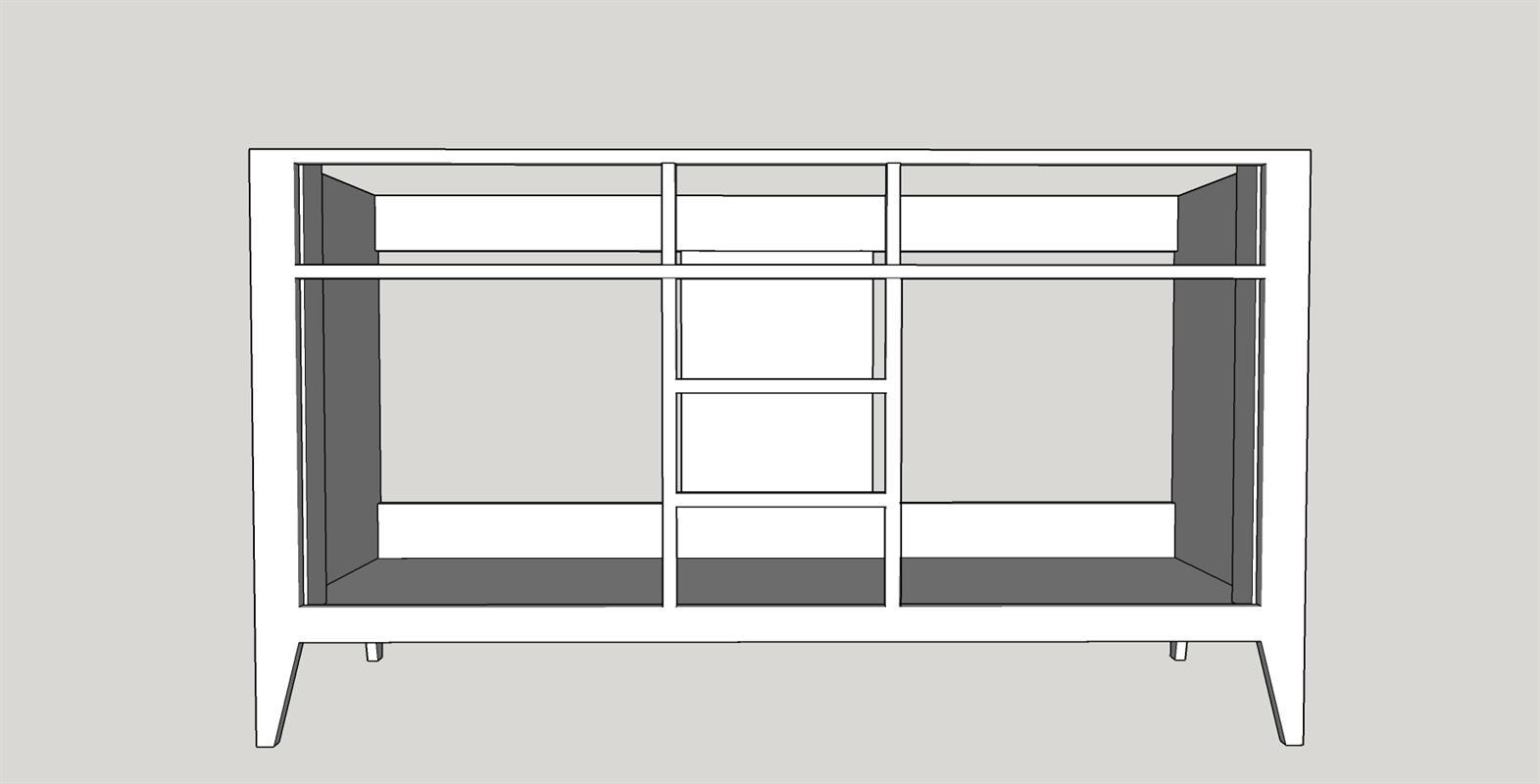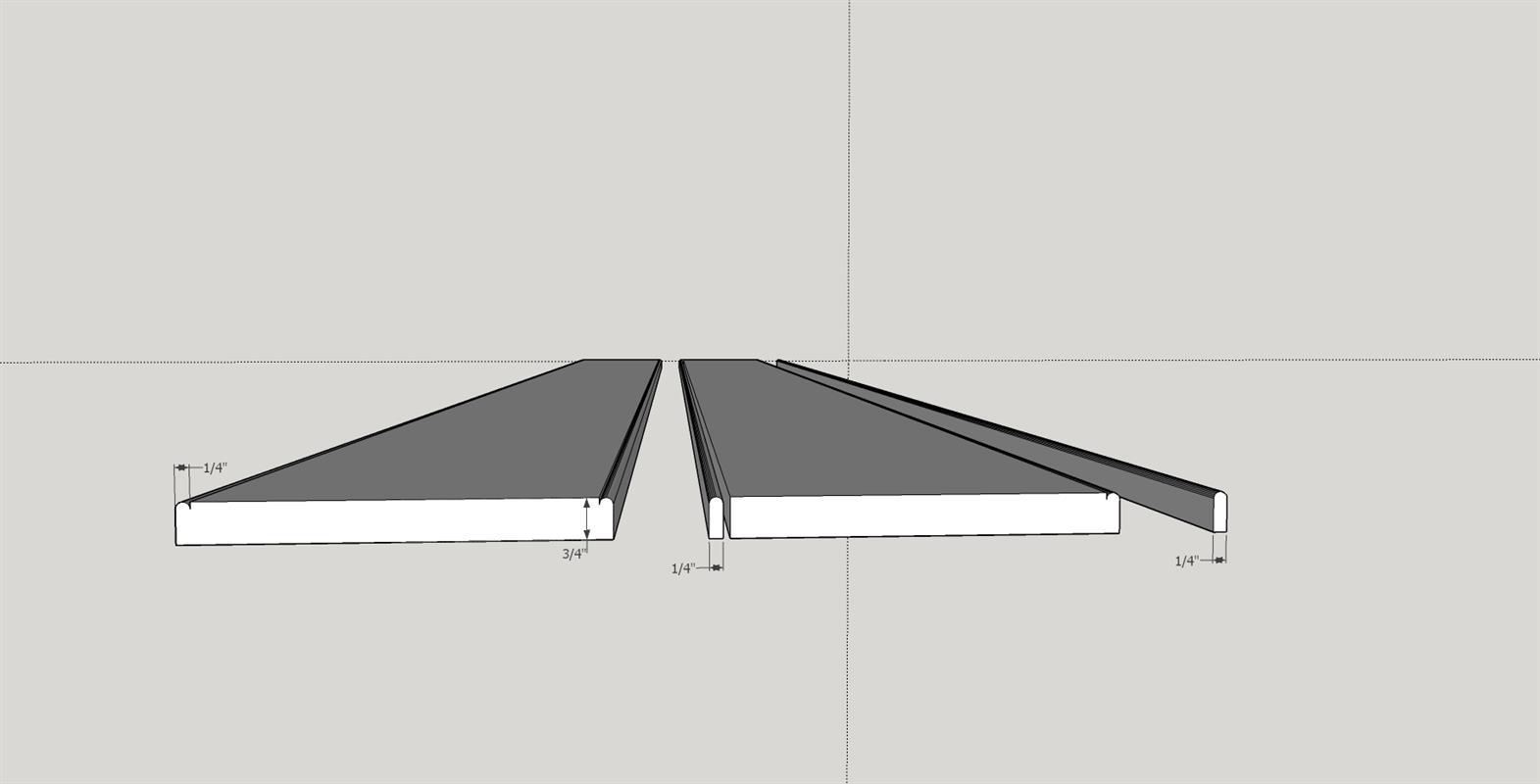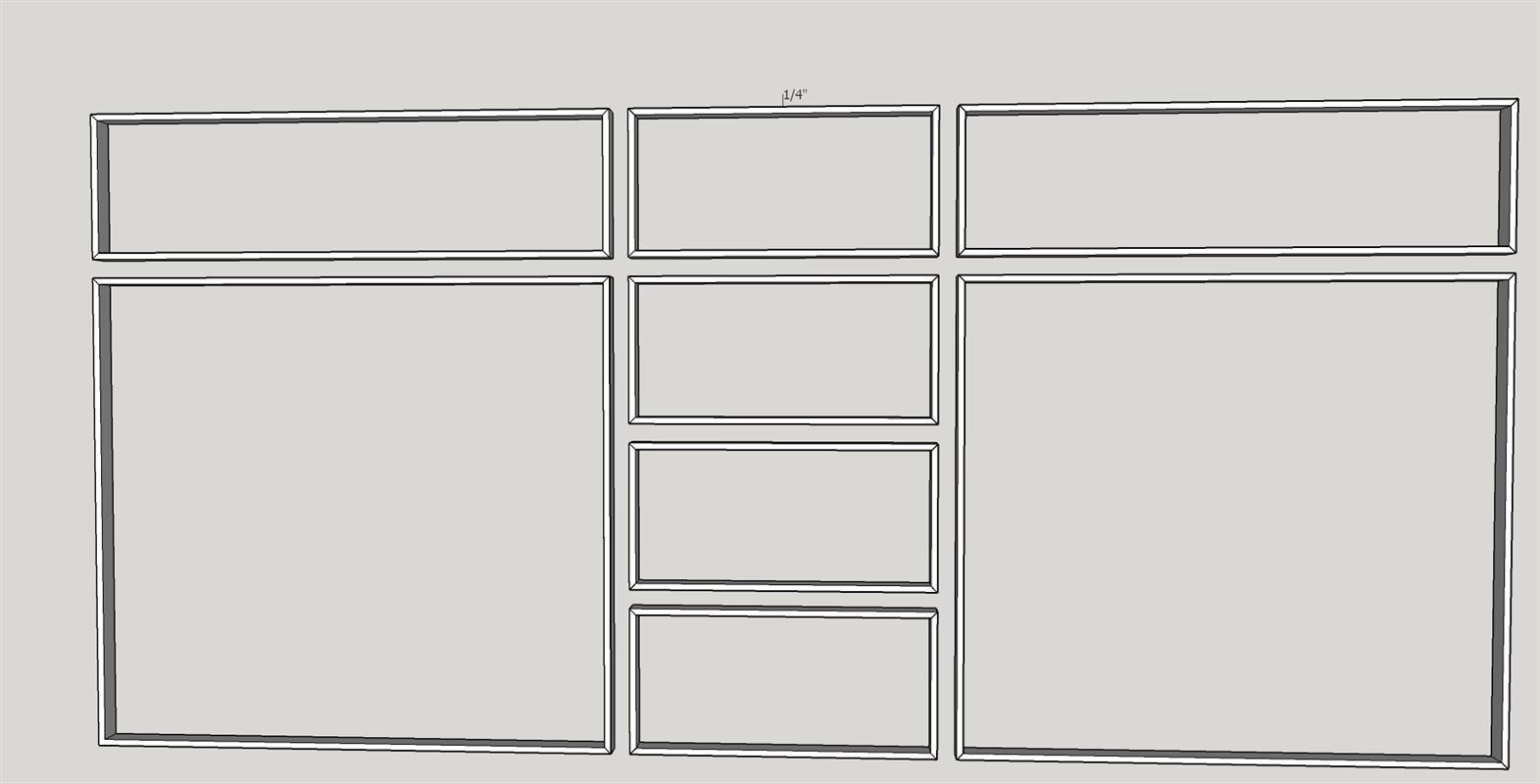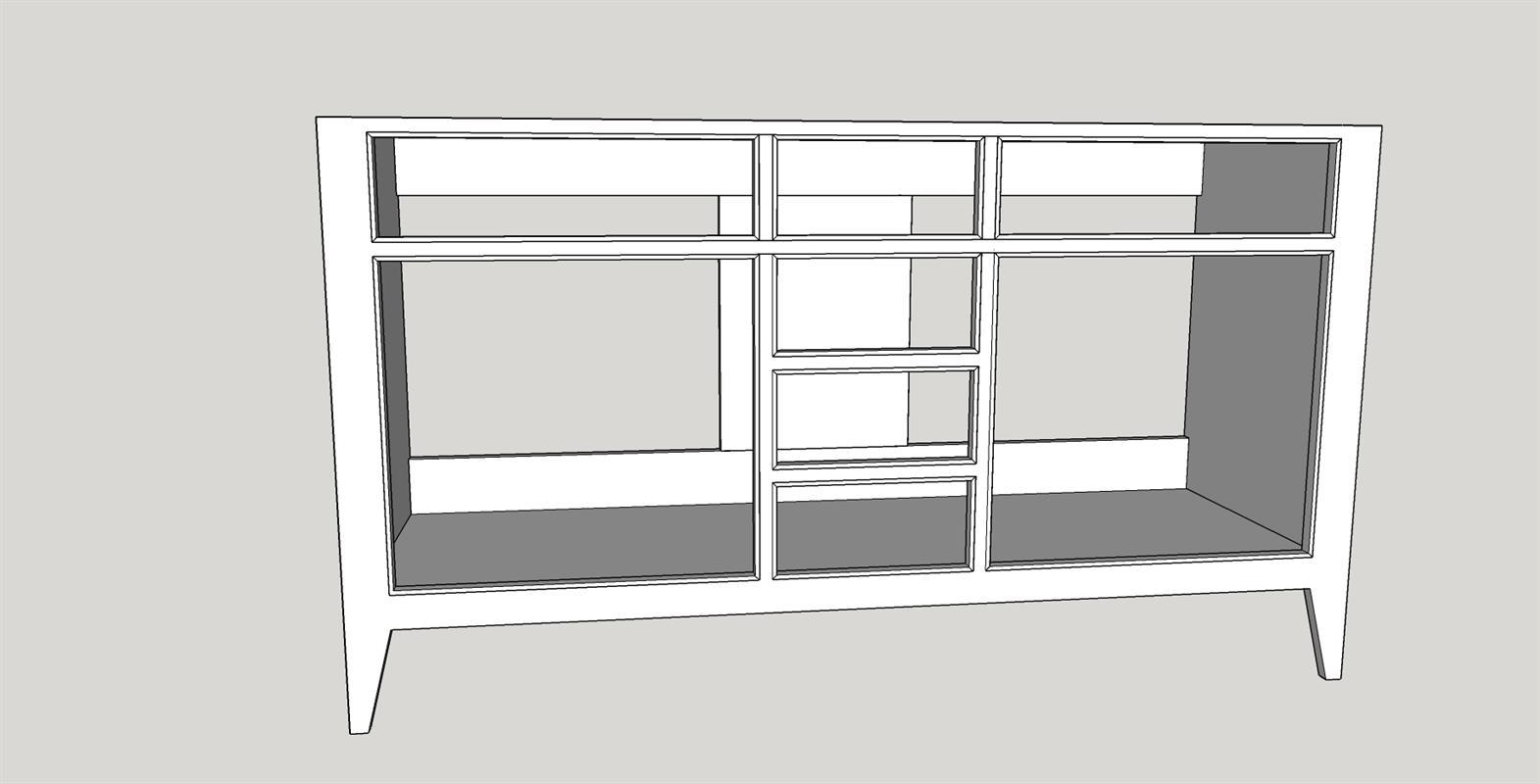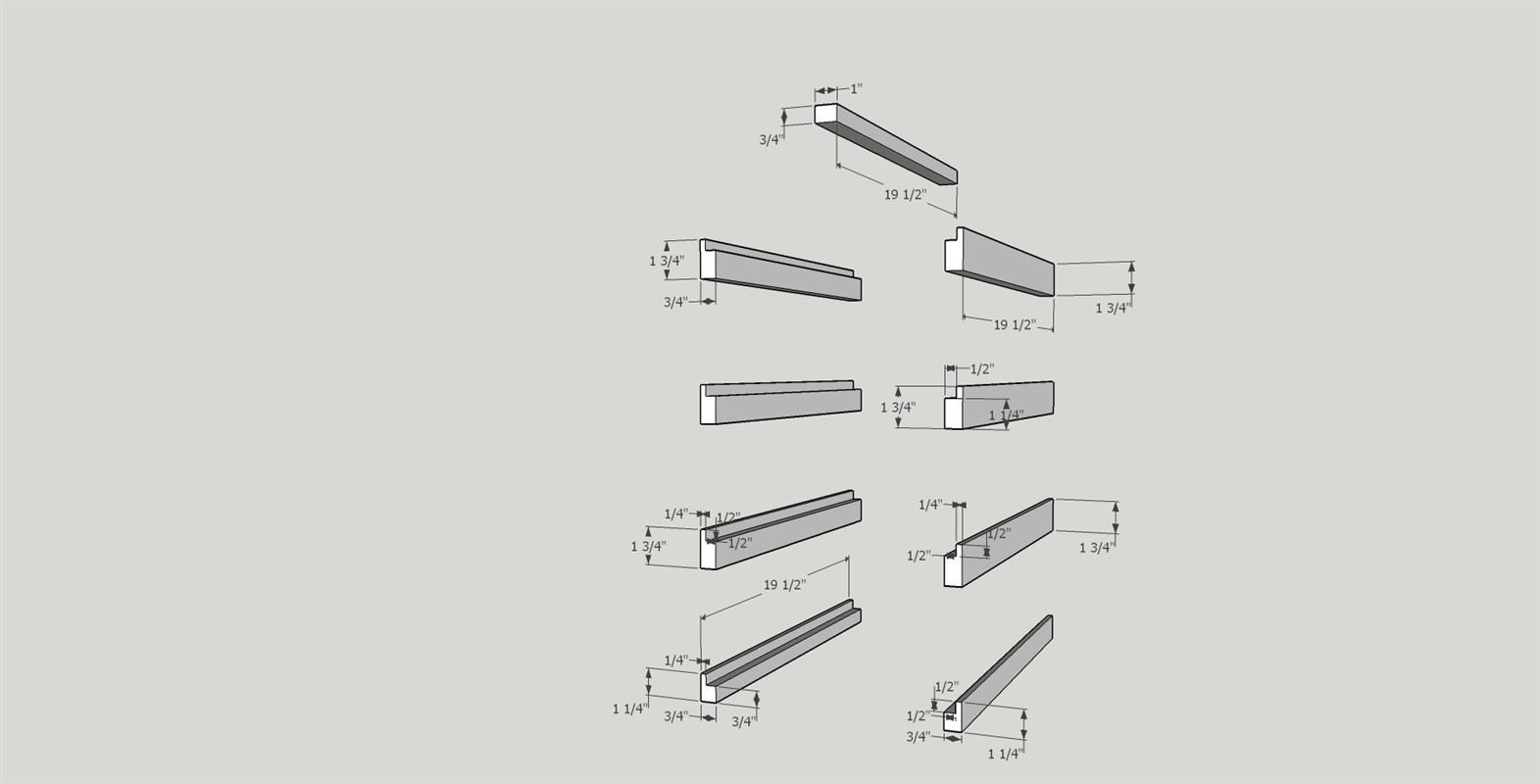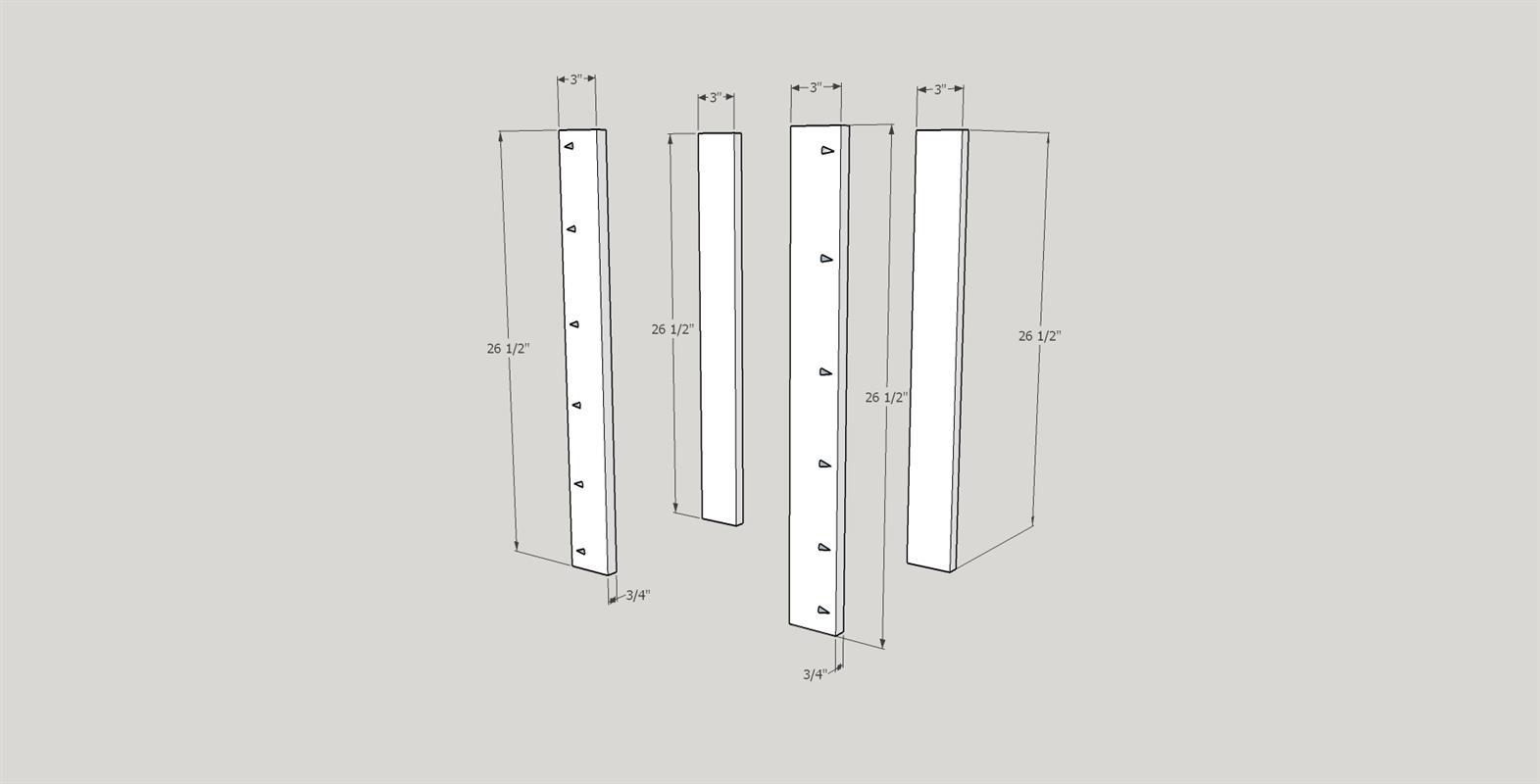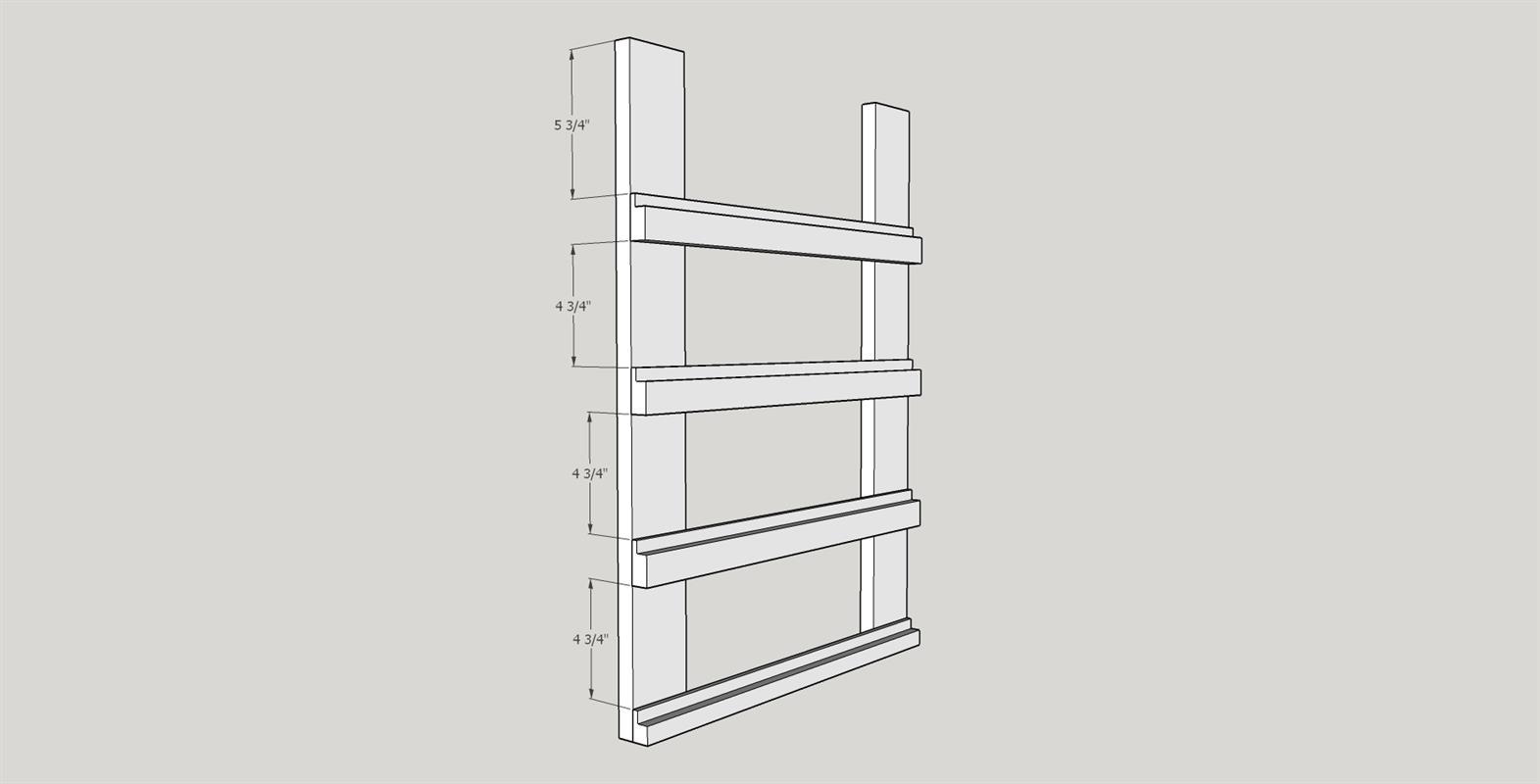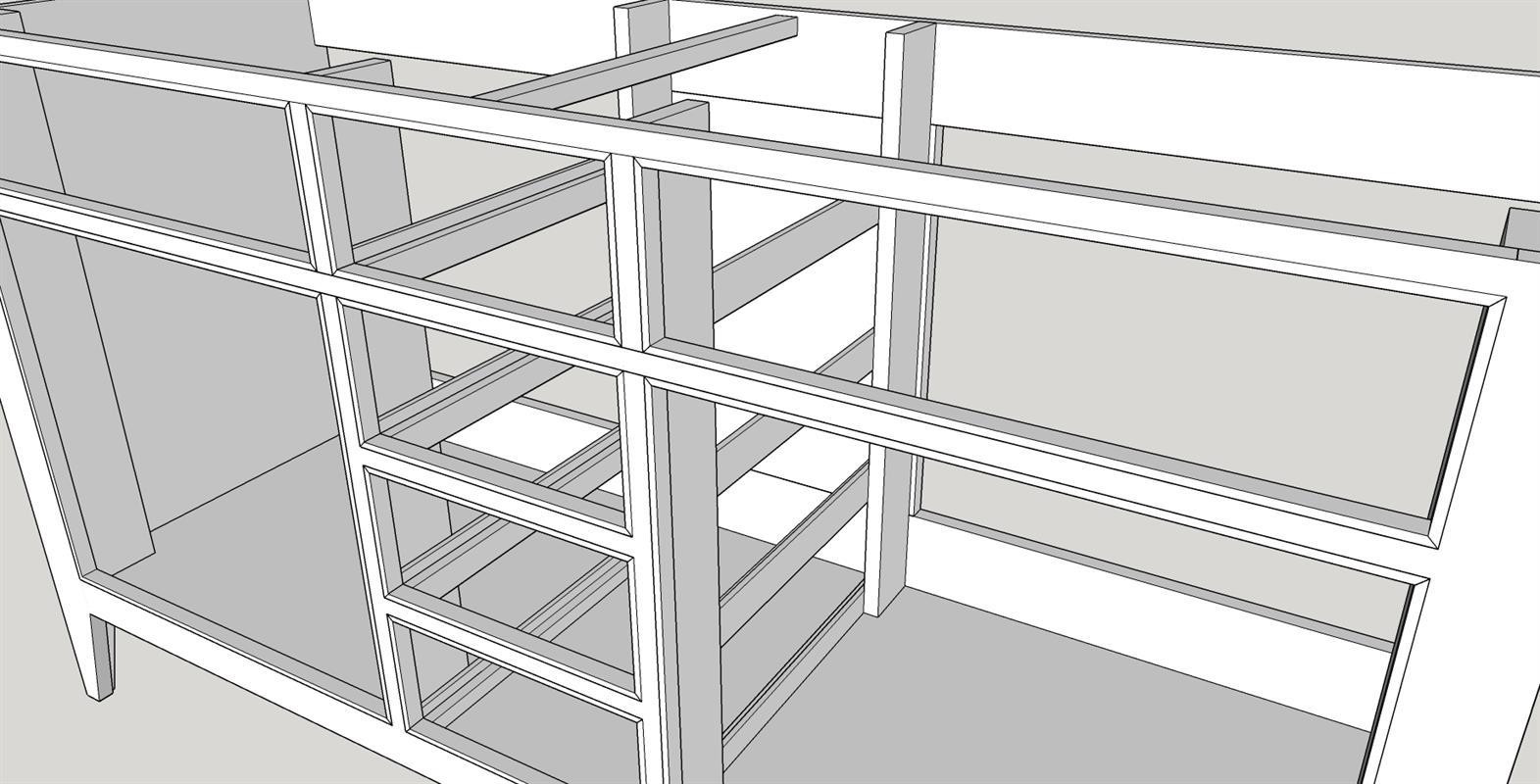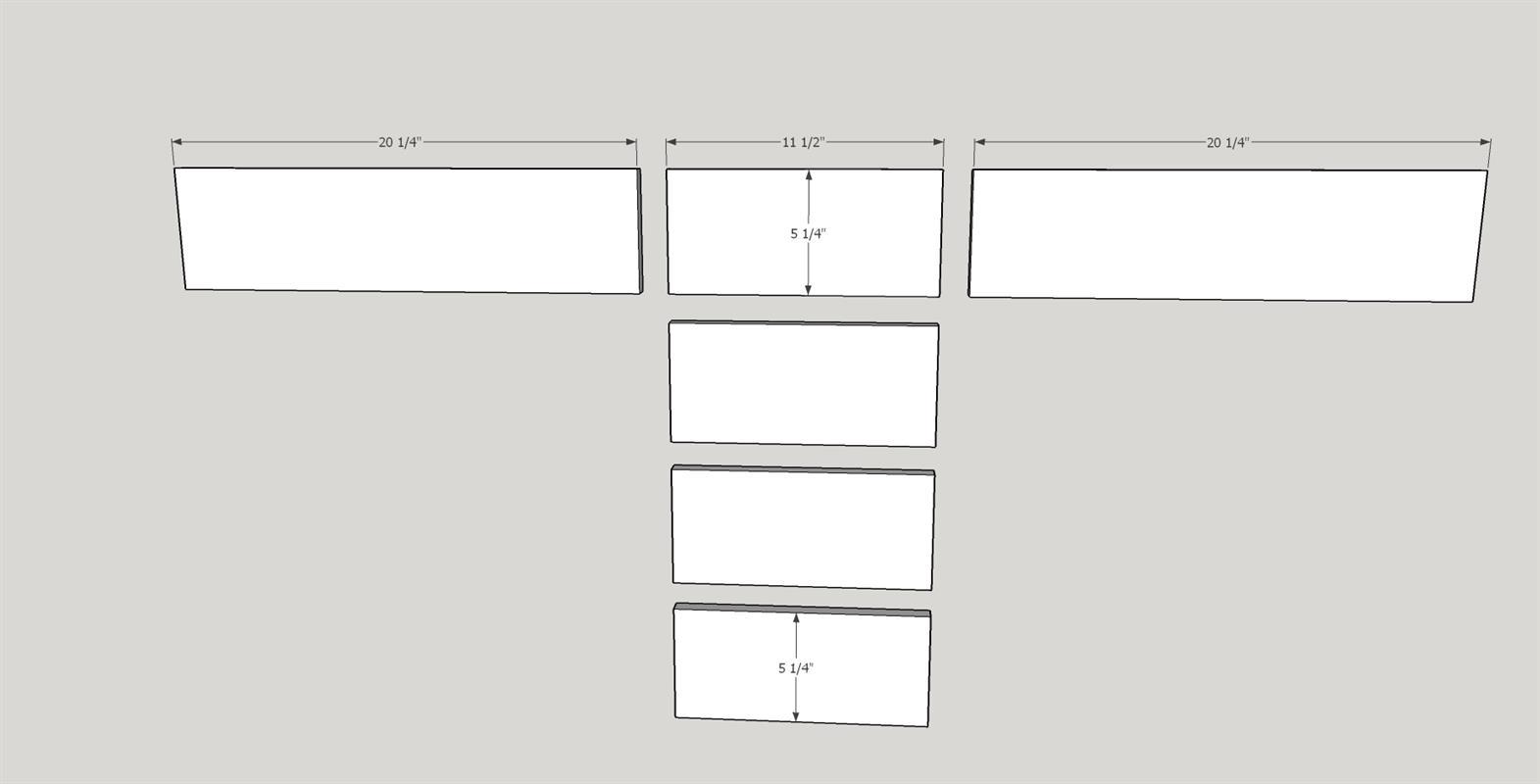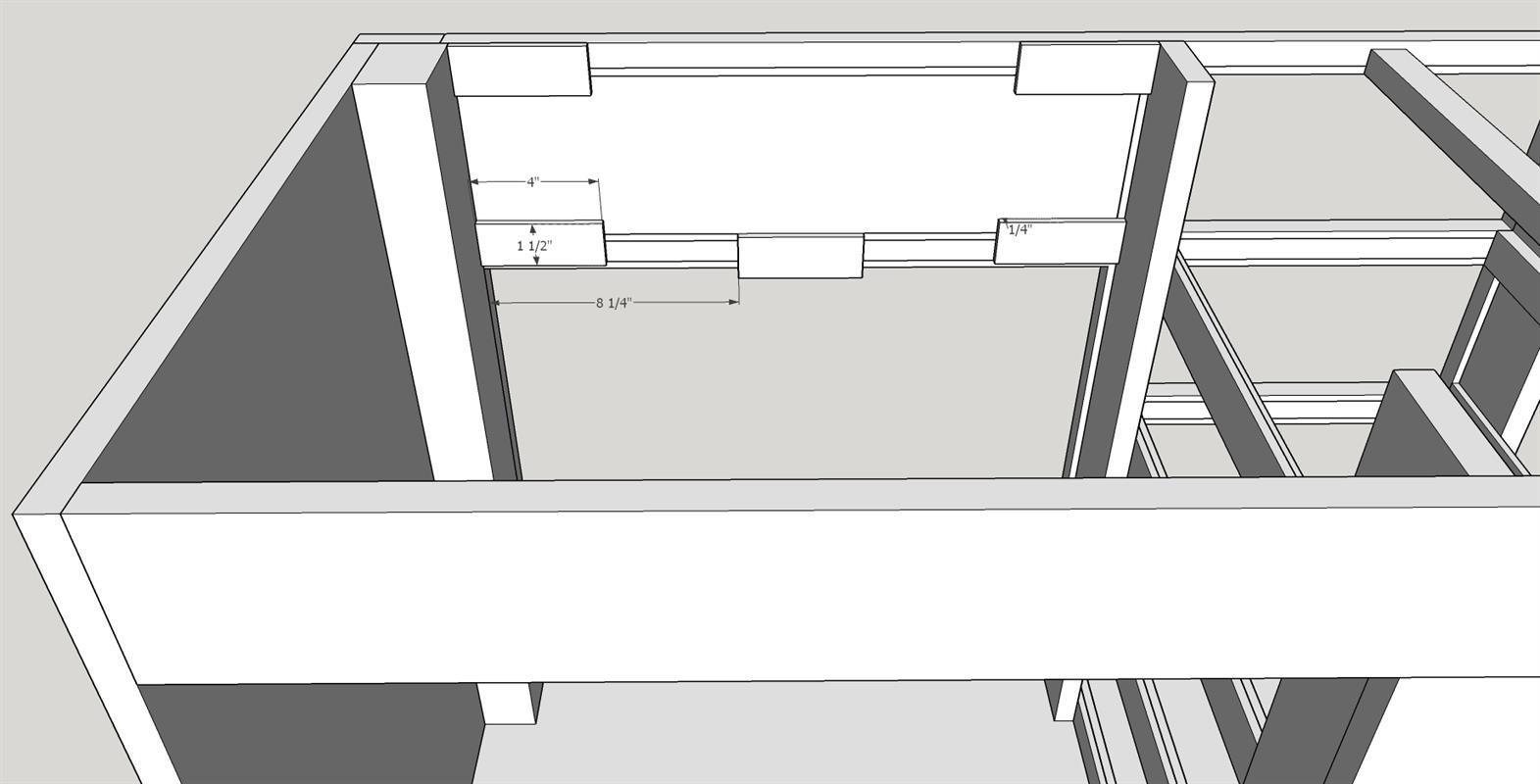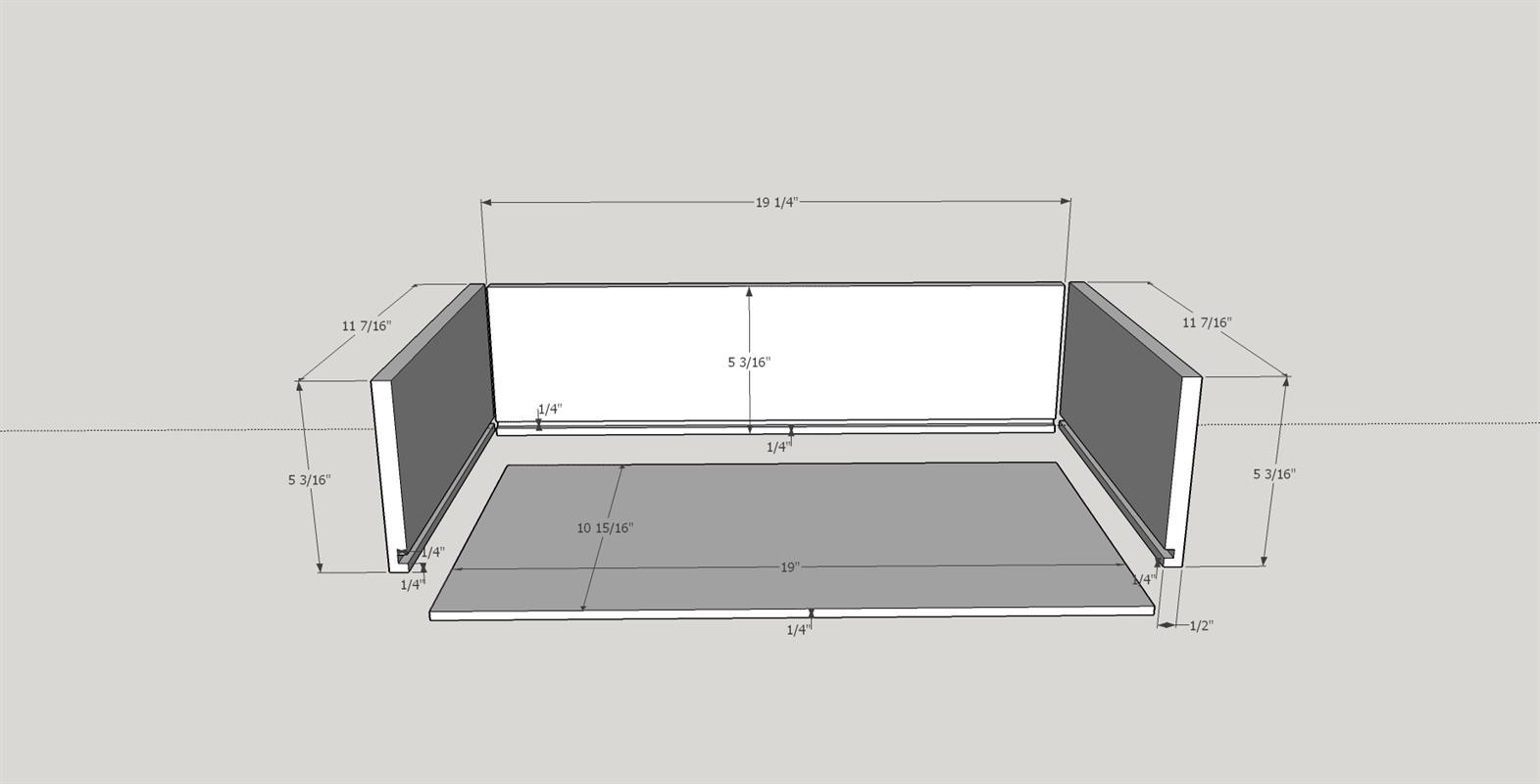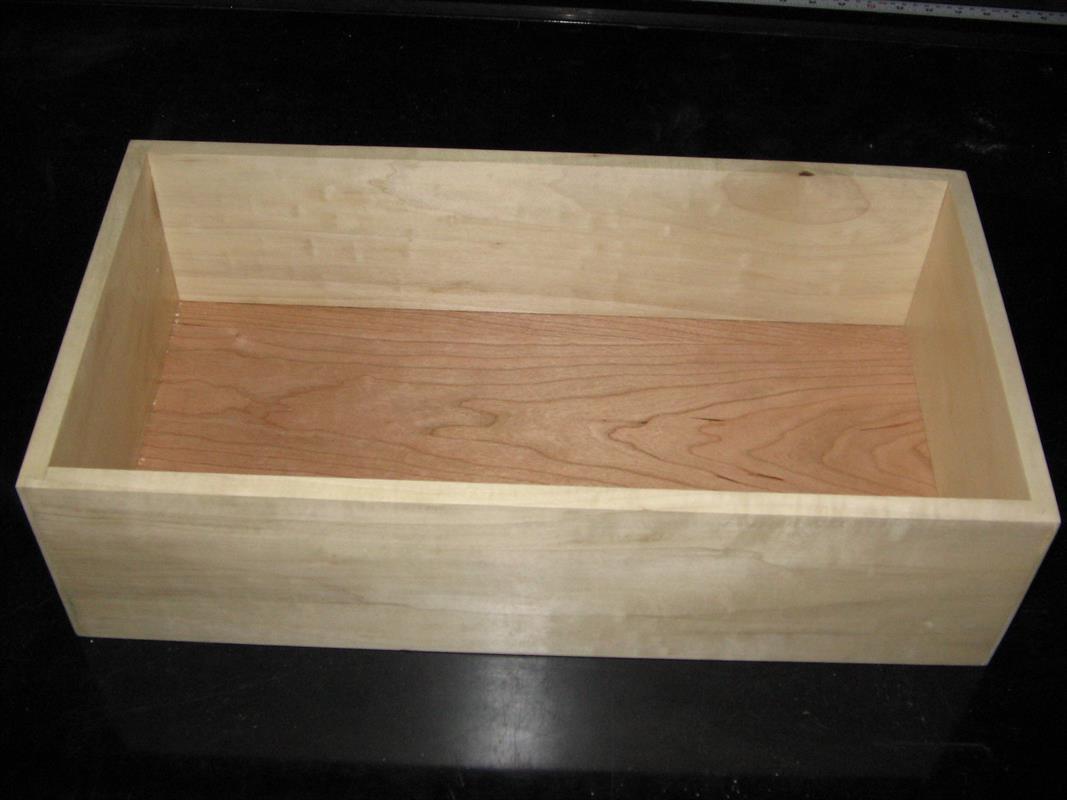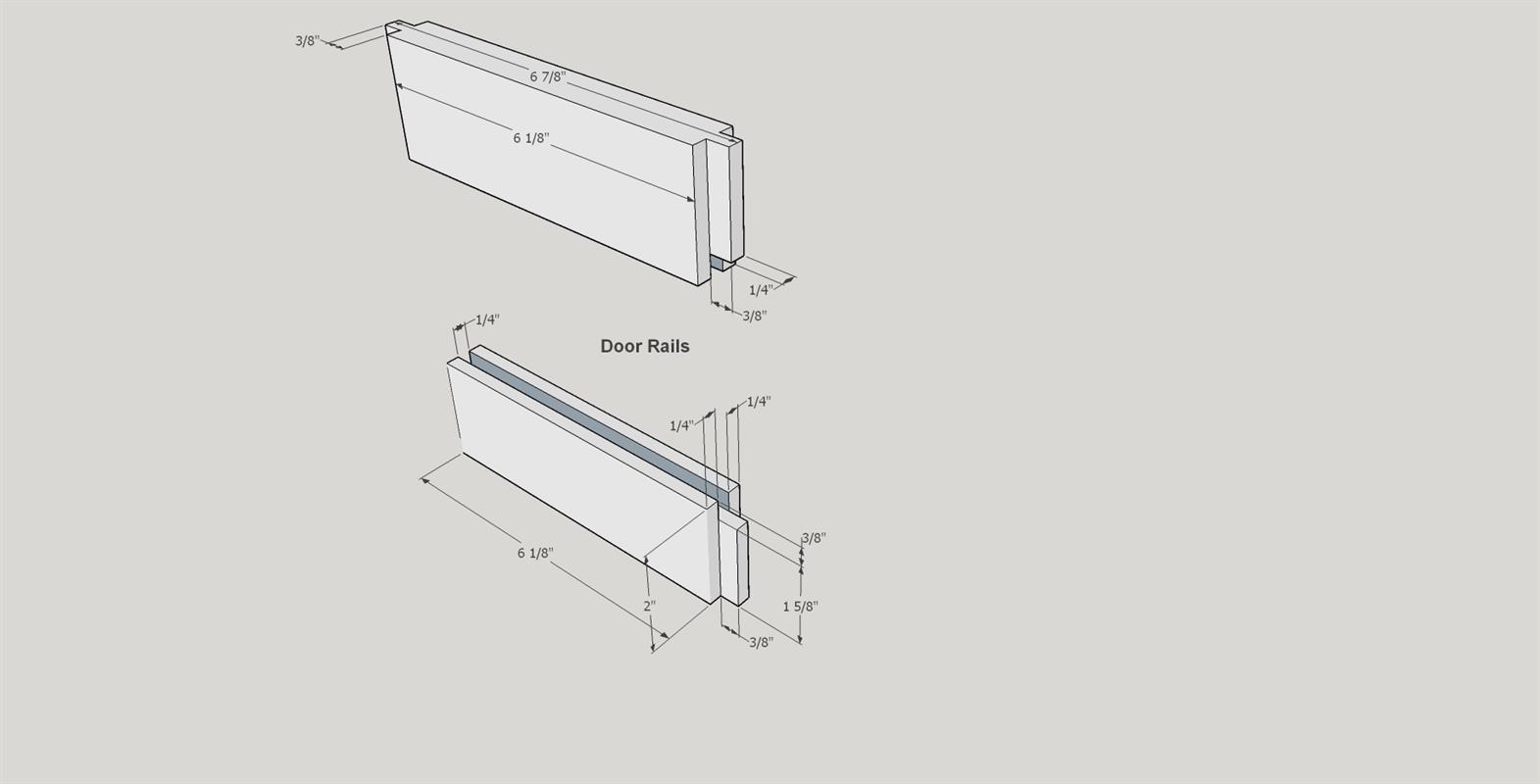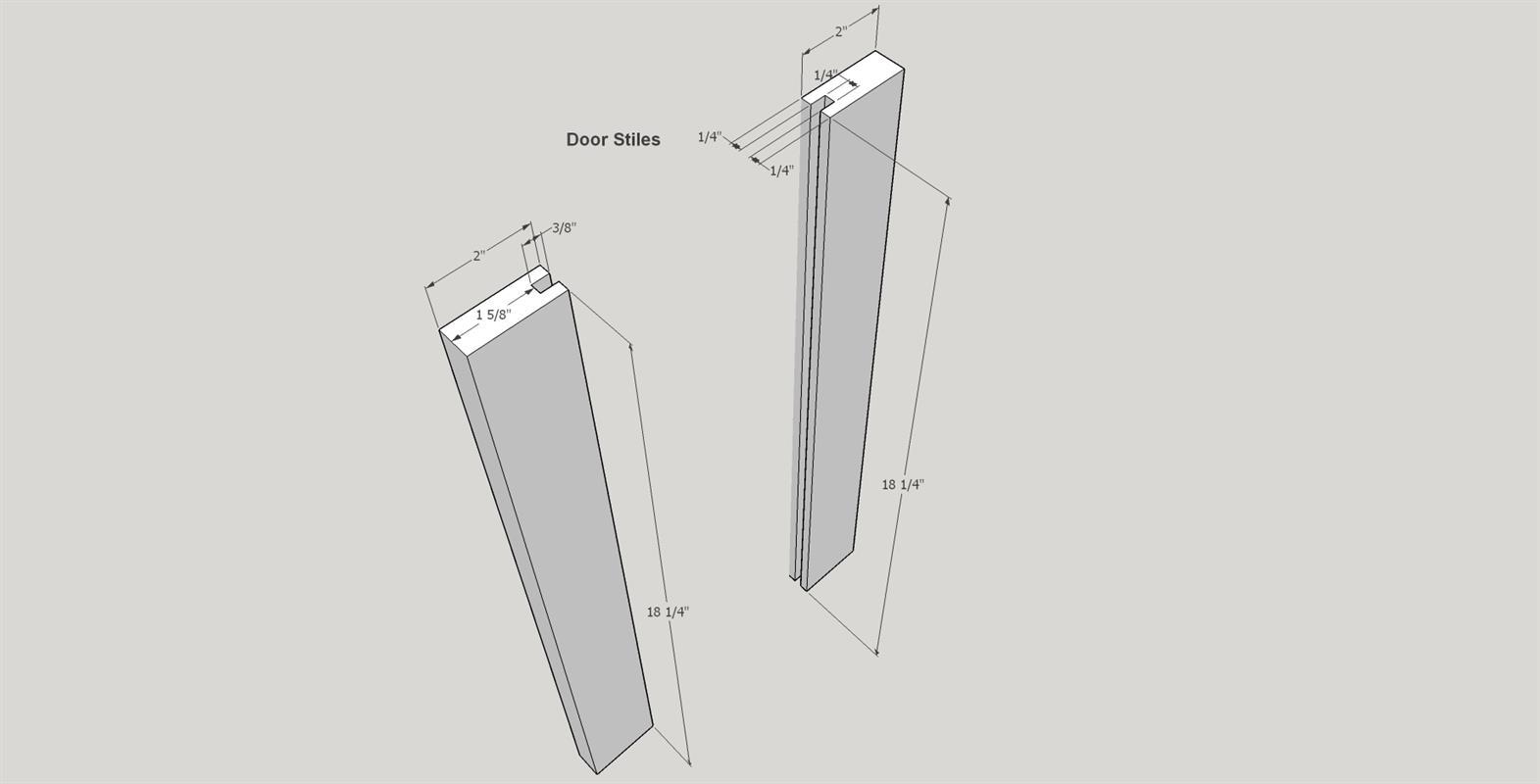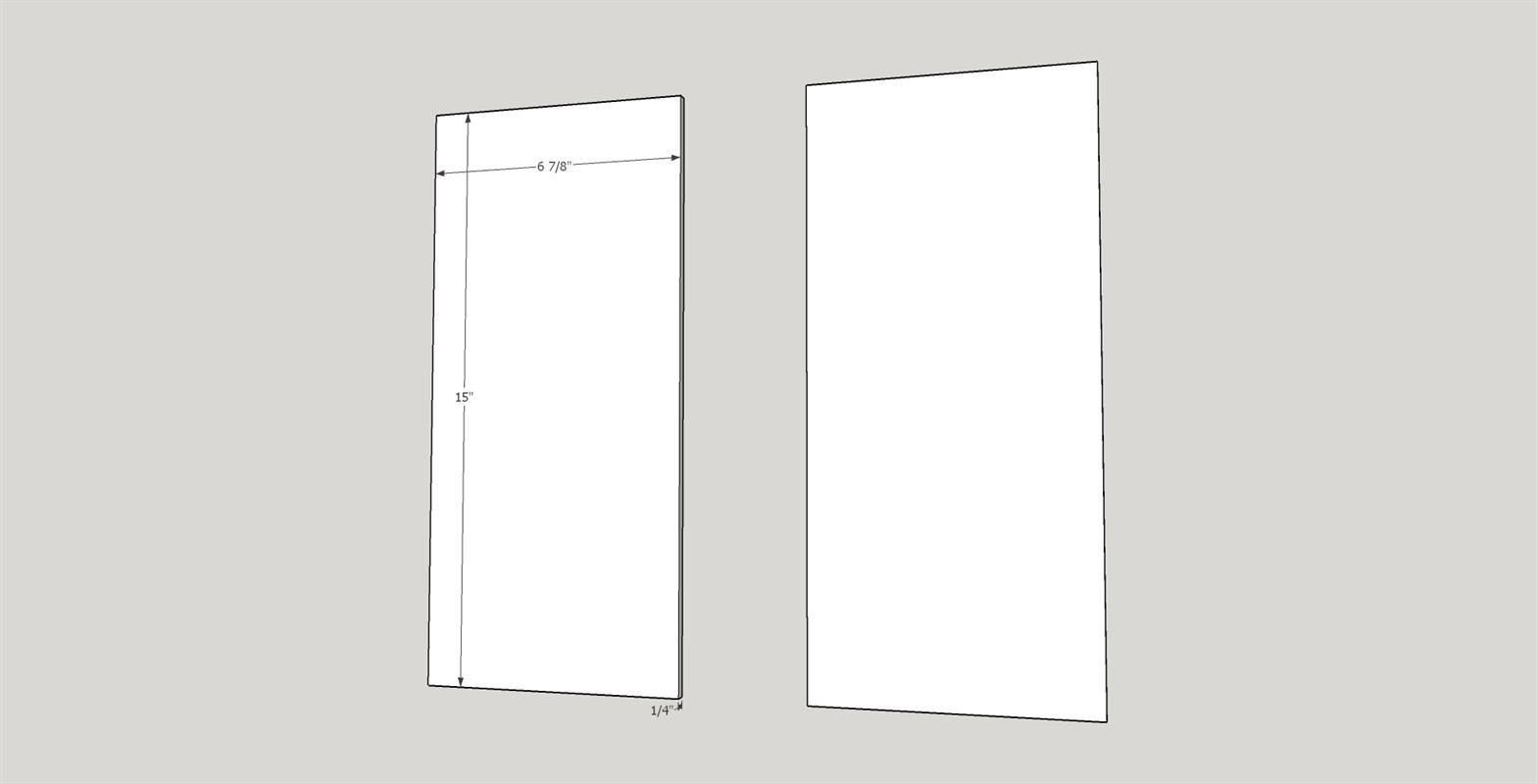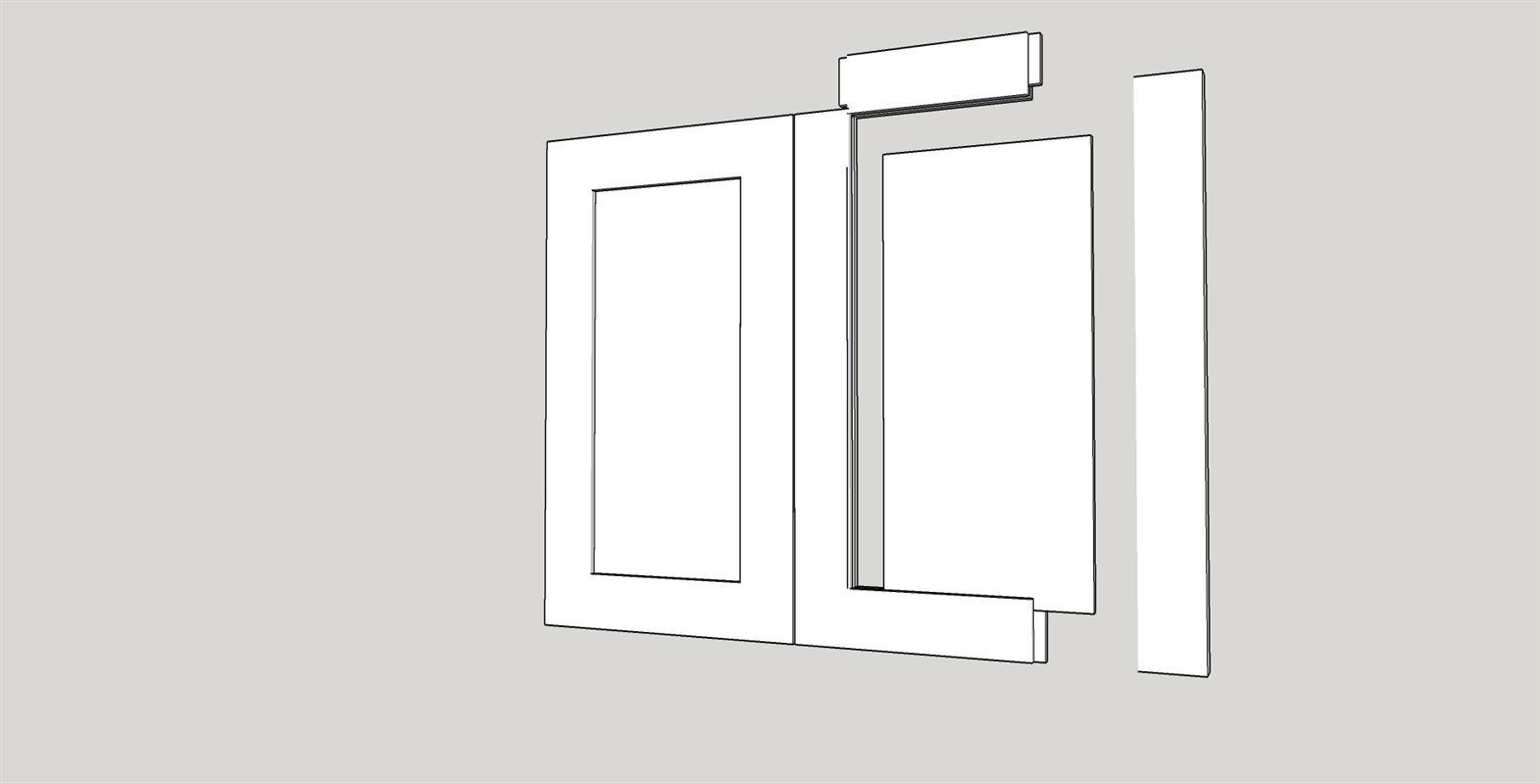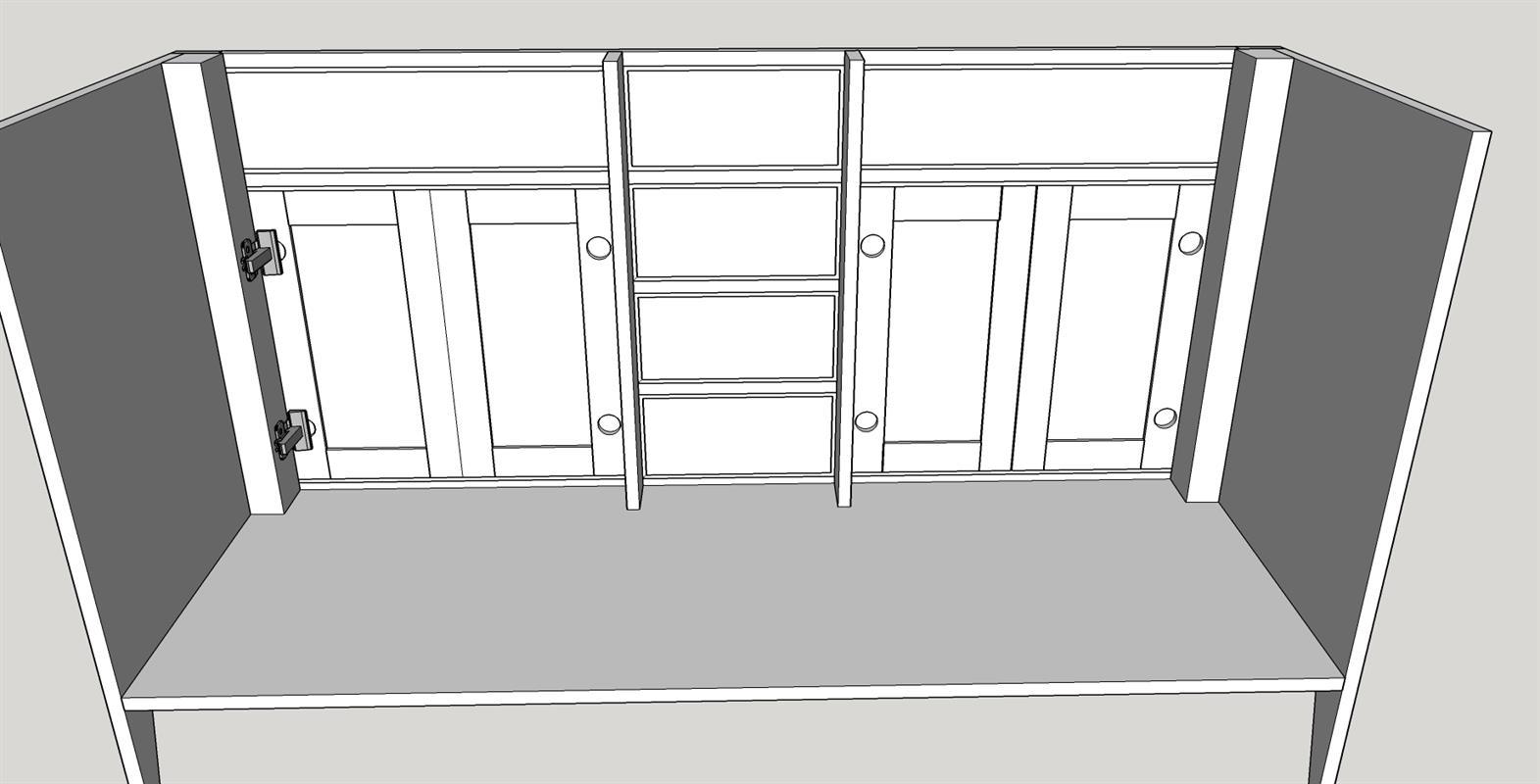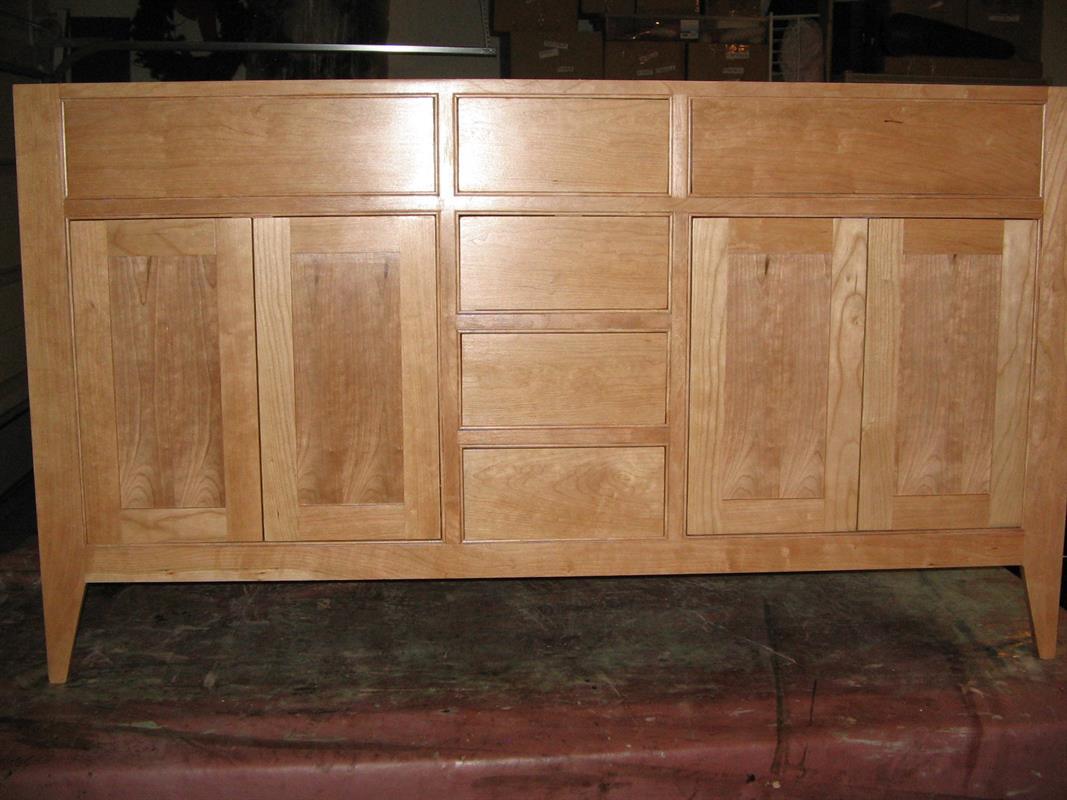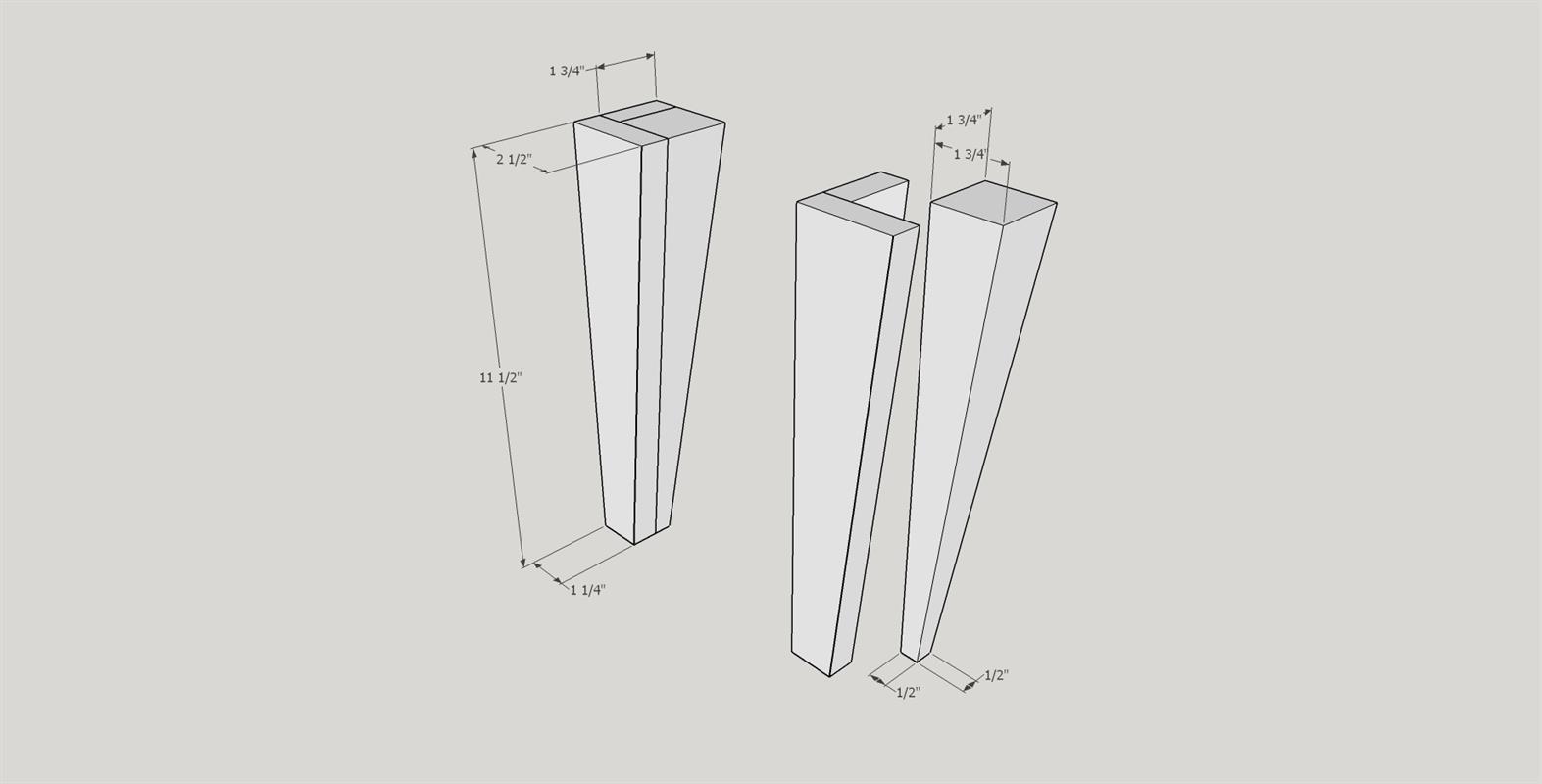Cherry Bath Vanity – 60 inch
By fcbeckerShaker style cherry tall bath vanity with a 2 sink top. The cabinet has 4 centrally located drawers. There are 2 false drawer fronts and double doors on either side of the drawer stack. The doors and drawers are flush mounted and use a beading detail to accent the openings. Approximate cost $450.
Directions
-
Cut out main carcass pieces
Cut the vanity sides, bottom and rear drawer support from the 3/4" plywood sheet.
-
Cut leg openings
Using a band saw or jig saw cut the leg openings in both side pieces. Use care to get a smooth cut with no tear out. Also keep in mind that you will be cutting a left and right side...so keep the best looking side out on both.
-
Add pocket holes to main carcass
Use Kreg pocket screw jig (set to 3/4" for all pockets on this project), drill pocket holes in both ends of the 3/4" plywood bottom cut in step two. It is a good idea to mark where you are putting the holes to prevent mistakes.
-
Prepare back frame
Cut 2 back frame boards from 3/4" poplar. Use Kreg jig to place pocket holes in both ends of the top and bottom pieces. Also place pockets along the bottom edge of the bottom piece. Again it is a good idea to mark where you will be placing the pockets to prevent errors.
-
Add pocket holes to drawer support
Use Kreg jig to place pocket holes in both the top and bottom of the 3/4" plywood rear drawer support (cut in step two). Again it is a good idea to mark where you will be placing the pockets to prevent errors.
-
Assemble carcass
Assemble sides, bottom, back frame and rear drawer support piece using Titebond wood glue and 1 1/4" coarse Kreg pocket screws. Please note...all pocket screws on the bottom should face down and all pocket screws on the back should face back. No pockets should be visible on the inside of the assembly.
-
Sand
Sand all of the pieces that you have prepared so far. I normally use 100 grit to begin with and finish up with 150 grit. It is much easier to complete this phase of sanding before you begin assembly. I will use 220 grit for a final hand sanding after assembly is complete.
-
Important information
Please be sure to read through complete instructions before you begin any work on this project. My cost estimate for materials is based on using rough lumber that I process to the correct dimensions. Pre planed dimensional lumber will be more expensive. Also keep in mind that plywood may be slightly thinner than its stated thickness. 3/4" plywood may actually be 23/32". So some minor adjustments to plans may be required. Another good practice you should use, is after the original carcass is assembled all additional pieces that are needed should be cut to fit. While every effort was made to make the cut dimensions listed as accurate as possible, cutting to fit will adjust for any slight discrepancies in your assembly.
-
Cut out face frame
From the 3/4" cherry lumber cut out the 11 pieces that make up the face frame. Using a jig saw or band saw cut the leg angle on the two outside stiles. (leg is 6 inches)
-
Add pocket screw holes and assemble
Using a Kreg pocket hole jig, drill pocket holes in the ends of all face frame pieces with the exception of the outside stiles. Again it is a good idea to mark where each hole will be drilled to prevent mistakes. Assemble face frame using wood glue and Kreg 1 1/4" fine pocket screws. I use the top of my table saw for assembly as it provides a large flat area to work.
-
Outside door hinge frame supports
Cut outside door hinge frame supports from 2" dimensional poplar. If you do not have access to 2" dimensional poplar you can laminate several boards and cut to final dimensions. After completing your cuts, sand the hinge frames, using 150 grit for the final smoothing. Using wood glue and brad nails attach the frames to the front of the assembled carcass as pictured.
-
Attach face frame
Once the wood glue is dry sand both sides and all edges of the face frame ending with 150 grit sandpaper. Attach the face frame to the front of the carcass with wood glue and 1 1/4" brad nails. Two things to note. The first is that if the plywood sides of the carcass are less than 3/4" actual dimension the face frame might be slightly wider than the carcass. If that is the case divide the face frame overlap evenly on both ends of the carcass and then attach. Secondly you will see that the outside door frame hinge supports are 1/4" wider than the face frame. Do not worry. The beading frames that will be added cover the framing.
-
Making the beading accent
The beading frames will require over 34 linear feet of 1/4" beading.To manufacture this I use a Freud (80-102) 1/8" Radius Tradition Beading Router Bit. I mount the bit in my Kreg Router Table and set the cutting height to 3/8". I start with a 1 X 8 X 96" cherry board and cut a bead on either edge of the board. I then use my table saw to rip a 1/4 inch piece off each edge. I repeat this process two more times until I had 48 linear feet of beading (it is usually a good idea to made extra). It is very important to hold the board tightly in place when cutting. I use Kreg feather boards on the router table and a Grip-Tite Guide(TM) magnetic featherboard on my table saw. Finally use 150 grit sandpaper to smooth the beading.
-
Installing the beading frames
Both door openings, the two false drawer front openings and the four drawer openings are framed with beading. This is accomplished by cutting the beading to fit each side of each opening (all cuts are 45 degree angles to create mitered corners). I make all of the 45 degree cuts with my Bosch chop saw (the beading was usually cut a little long and nibbled away until each piece fits tightly in place). Once I have all of the frames cut and fit in place I use wood glue and pin nails for final assembly. Please use care to keep the beading flush to the front of the face frame.
-
Complete carcuss
Fill all brad and pin nail holes with a good quality wood putty. Allow to dry and sand smooth with 150 grit sandpaper. The outer carcass is now complete.
-
Cut drawer slides and keeper
I use close grain, quarter sawn red oak to make my drawer keeper and slides. Oak holds up well to wear and quarter sawn wood is more likely to hold its shape and is less likely to twist or warp. Using my table saw I rip the drawer slides and keeper (top drawer guide) from 3/4" oak. I then use my chop saw to cut to length. Then I set up the table saw with my dado blade and cut all of the 1/2" X 1/2" rabbets in the drawer slides. I sand the rabbets and apply paste wax to help the drawers slide easily.
-
Cut the drawer slide supports
From a 3/4" poplar board cut the four drawer slide supports. Using the Kreg pocket hole jig drill pocket holes in all four boards. Again it is a good idea to mark where each hole will be drilled to prevent mistakes.
-
Build drawer slide sub assemblies
We now build two identical drawer slide sub assemblies. One will become the left and the other will be the right assembly. Begin by placing the bottom slide flush with the outside corners of the support boards and use a square to make sure they align properly. Use wood glue and 1 1/4" brad nails to attach. (Make sure the pocket holes in the support boards are on the opposite side of the drawer slides and the pocket holes are facing outwards). To insure correct spacing use a 4 3/4" X 19 1/2" rectangular template of 1/8" masonite (cut very accurately to dimension and checked for square) to place the other three drawer slides. Attach each slide with wood glue and brad nails. Repeat this process for the second sub assembly.
-
Placing the drawer slide assemblies
Each drawer slide sub assembly will now be placed in the vanity carcass. If we measured and built correctly, we should be able to line up each drawer slide with the lower corner of each drawer opening at the front of the vanity. Once you have completed lining this up, clamp the assemblies in place at the front. Do not clamp the rear. Use Kreg 1 1/4" fine pocket screws to attach the front of the assemblies. You can use a framing square or a 19 1/2" X 10 1/2" rectangular template to set the position of the rear assemblies. (The template is inserted as if it were a drawer) Once all is square clamp the rear assemblies and use Kreg 1 1/4" coarse pocket screws to make the final attachment.
-
Installing the top drawer keeper.
Install the drawer keeper we cut in step 17. The keeper should fit tightly between the top face frame and the top back frame. It should be centrally located between the two slide sub assemblies and flush with the beading frame of the top drawer opening (about 1/4" down from the top of the face frame and the same distance down in the back). Use wood glue and brad nails to fix in place.
-
Cut the drawer fronts
I make the drawers by building drawer boxes and adding the drawer fronts to the completed boxes. In this step we will be cutting the two false drawer fronts and the four drawer fronts for the central stack. Measure the openings and cut the two false drawer fronts to be a tight fit to their openings. Measure each of the openings of the drawer stack and cut the drawer fronts to be 1/32" - 1/16" smaller than the openings. After cutting, fit all drawer fronts and make any adjustments needed to fit properly. Sand all of the pieces ending with 150 grit for final finish.
-
Install false drawer fronts
Place the two false drawer fronts in their openings. They should fit flush with the beading frame. Use four small wooden boards that are glued and pin nailed at each back corner of the false draw front to fix each in place. Add a fifth board to the top center of the door opening. This will act as a door stop and will hold the doors in the correct position when closed.
-
Building the drawer boxes
Cut the eight drawer sides and eight drawer fronts/backs from 1/2" poplar (you can use 1/2" plywood but watch the thickness as it might be slightly less than 1/2"). Cut the four drawer bottoms from 1/4" plywood. Please note that my sizes are approximate and will vary depending on how you construct the box corners. The box final dimensions should be 11 7/16" X 19 1/2" X 5 3/16". I use a Freud (99-240) Drawer lock bit on my Kreg router table to cut all of the corners. I then use my table saw to cut a 1/4" deep X 1/4 inch wide dado in all sides and fronts/backs. This dado should be 1/4 inch up from the bottom of each board. Once you have completed all of the operations prep all surfaces with 150 grit sandpaper.
-
Assemble the drawer boxes
Assemble using two sides, a back, a front and a bottom. I use wood glue at each corner joint and on the edges of the plywood bottom. You can either clamp until the drawers are dry or use pin nails in each corner. Repeat this process three more times until all drawer boxes are complete.
-
Install drawer fronts
Insert the bottom drawer box into the frame. Place the drawer front into the bottom opening. Use shims to adjust the door front so that there is an equal amount of space on both sides and top to bottom. Place two 1" self tapping screws from the inside front of the drawer box into the drawer front. Repeat this process for each of the remaining drawers.
-
Cut door rails
Cut eight door rails from 3/4" cherry. Then use a Freud (99-036) Adjustable Tongue and Groove Bit set mounted in a Kreg router table to cut the tongues and grooves in the eight door rails. The bits are adjusted to cut 1/4" X 3/8" grooves and 1/4" X 3/8" tongues. Alternatively the tongues and groves can be cut on a table saw. Finish sand with 150 grit sandpaper.
-
Cut door stiles
Cut eight door stiles from 3/4" cherry. Then use a Freud (99-036) Adjustable Tongue and Groove Bit set mounted in a Kreg router table to cut the grooves in the eight door stiles. The bits are adjusted to cut 1/4" X 3/8" grooves. Alternatively the grooves can also be cut on a table saw. Finish sand with 150 grit sandpaper.
-
Cut door panels
Cut four door panels from 1/4" cherry plywood. Finish sand with 150 grit sandpaper.
-
Assemble doors
Using two door rails, two door stiles and a door panel assemble the doors. Place wood glue at each corner where the door rail tongues meet the door stiles and along the outer edge of the door panels. Clamp in place ...make sure the doors are square and if necessary readjust and re-clamp. Repeat this process three more times until all doors are assembled.
-
Installing door hinge cups
Place a set of doors in both openings. Mark each door so you can keep track of their position (example: left set left door - LLD, left set right door - LRD, right set left door - RLD, right set right door - RRD) we will use this positioning to drill the holes for the Euro style hinges. If the fit is tight, set up the table saw and take 1/32" off of each side. Reassemble and make sure that the doors have adequate clearance to open. On the inside of each door mark the spots where each hinge will be positioned. Remove the doors and use drill press with a 1 3/8" forstner bit to drill the 8 hinge holes with the dimensions recommended by the manufacturer of the hinges. Drill all 8 holes, fasten the hinge cups in place. Reposition the doors.
-
Attaching doors
On the inside of the cabinet mark the position of the hinge mounting plates. Pre drill small holes for the screws that hold the mounting plates. Attach mounting plates as per the hinge manufacturers instructions. After the doors are mounted use the various hinge adjustments to properly set the side to side and top to bottom distances on all four doors.
-
Finish
Now that the build is complete use 220 sandpaper to do a once over on all surfaces in preparation for the finish. Clean well to remove all dust. (I use compressed air and clean dry rags) I chose to just use a sealant and leave the cherry to darken on its own. I used Minwax Polycrylic Satin finish. I gave the vanity and drawer assemblies three coats following manufacturers instructions. After the finish has dried add door/drawer pulls.
-
If you need to reinforce the legs
I received a request on how to make the legs stronger if you were making 11 1/2 inch tall legs. Please see attached picture with my suggestion for using a reinforcing block at the back of the legs as well as increasing the bottom dimension by 1/4 inch.
-
Reinforcing the front legs
As requested here is a drawing of how to add a reinforcing block to the front legs if you made the legs 11 1/2 inches high. Please also note that I made the leg bottoms 1/4" wider for added strength.










